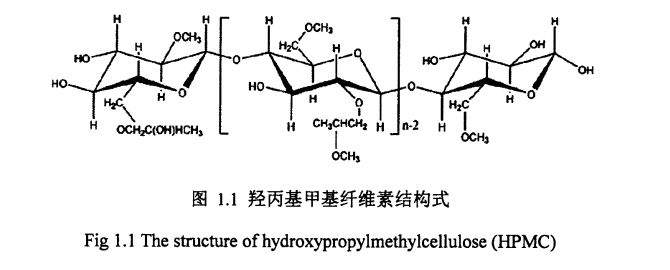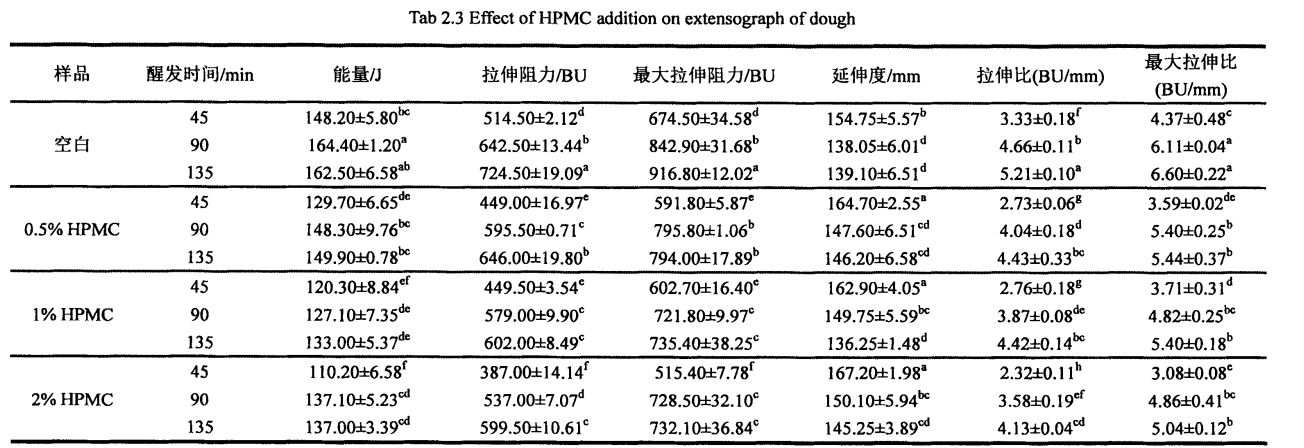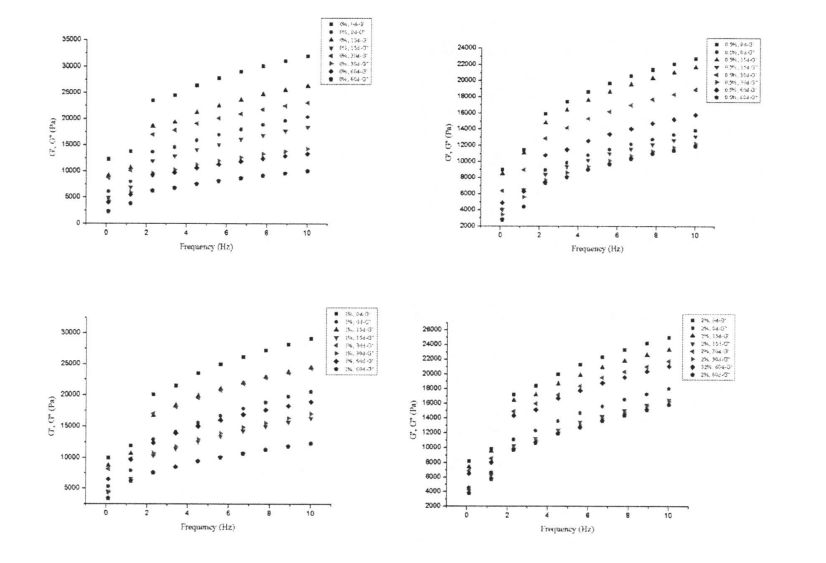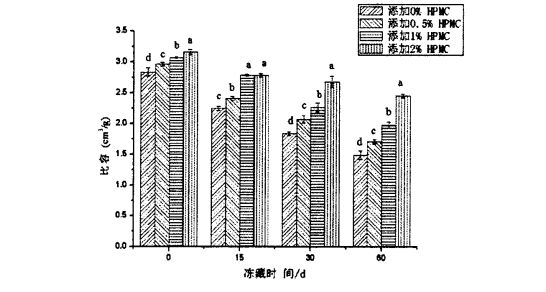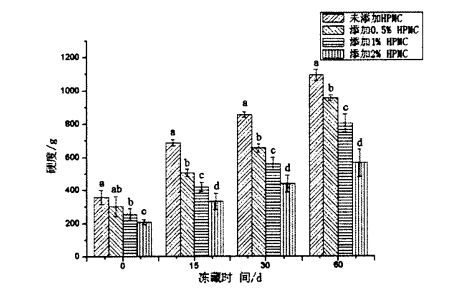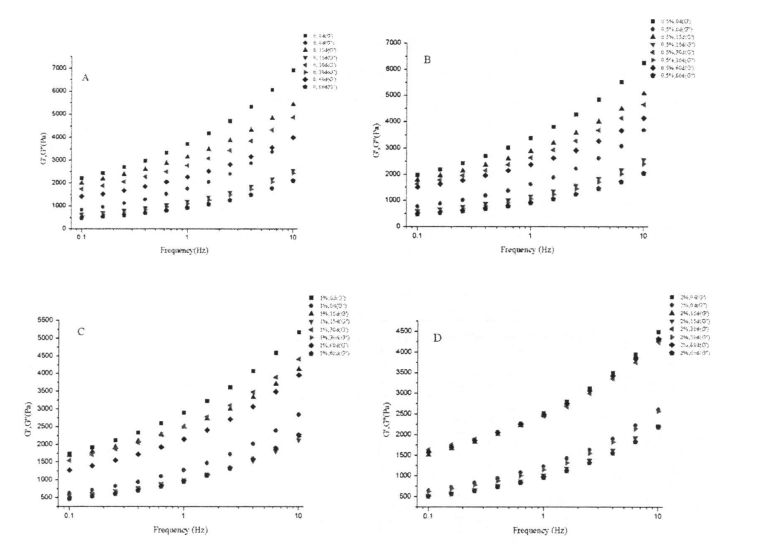Bandorên hîdrokypropyl methylcellulose (hpmc) li ser taybetmendiyên pêvajoyê yên diranên qirêj û mekanîzmayên têkildar
Improving the processing properties of frozen dough has certain practical significance for realizing large-scale production of high-quality convenient steamed bread. Di vê lêkolînê de, celebek nû ya hîdrophîlî Colloid (hîdrokyplopyl methylcellulose, yang, MC) hate sepandin. The effects of 0.5%, 1%, 2%) on the processing properties of frozen dough and the quality of steamed bread were evaluated to evaluate the improvement effect of HPMC. Bandor li ser struktur û taybetmendiyên pêkhateyan (giyayê giyayî, stêrka genim).
Gluten gluten bingeha materyalê ye ji bo pêkanîna strukturên tora drav. Experiments found that the addition of I--IPMC reduced the breakage of Yd and disulfide bonds between wheat gluten proteins during frozen storage. Wekî din, encamên resonansiyonên magnetîkî yên nizm û dîmenên cihêreng ên di navbêna avê de sînorkirî ne, û naveroka ava vexwarinê ya di dirûvê de kêm dibe, bi vî rengî bandora mezinbûna kristal a berfê li ser mîkrostructure gluten û lihevhatina wê ya spatial. Scanning electron microscope showed intuitively that the addition of HPMC could maintain the stability of gluten network structure.
Activityalakiya hilberîna gazê ya Fermentasyonê li ser kalîteya hilberên fêkiyên fêkiyan bandorek girîng heye. Through experiments, it was found that, compared with the control group, the addition of HPMC could better maintain the fermentation activity of yeast and reduce the increase rate of extracellular reduced glutathione content after 60 days of freezing, and within a certain range, The protective effect of HPMC was positively correlated with its addition amount.
Key words: steamed bread; frozen dough; hydroxypropyl methylcellulose; wheat gluten; wheat starch; havên.
Chapter 1 Preface ................................................................................................................................. 1
1.1.2 Research status of steamed buns……………………………………………… . . ............ 1
1.1.4 Pirsgirêk û pirsgirêkên dirûşmên fêkî .................................................................................................................................................................................................................................................................................................................................................................. ..
1.1.6 Serlêdana Hydrocolloids di başkirina kalîteya dirûşm a frozen de ..................... .5
1.1.7 Hydroxypropyl methyl cellulose (Hydroxypropyl methyl cellulose, I-IPMC) ………. 5
Beşa 2 Bandorên HPMC-ê li ser taybetmendiyên pêvajoyê yên dirûvê dirûnê û kalîteya nanê steamed .................................................................................................................................................................................................................................................................................................................
2.1 Destpêk ...................................................................................................................................................................................................................... ..
2.3 Experimental results and discussion…………………………………………………………………… . 11
2.3.5 Bandorên HPMC-ê ya HPMC-ê ya li ser naveroka avê ya serbest (GW) li ser naveroka freezable (gw)
2.3.6 Bandora Adrêgê HPMC-ê û dema serbestberdana li ser kalîteya nanê steamed ................................................................................................................................................................
2.4 Chapter Summary ..........................................................................................................................21
Beşa 3 Bandorên HPMC-ê li ser struktur û taybetmendiyên gluten gluten di bin şertên azadkirinê de ............................................................
3.1 Destpêk ......................................................................................................................................
3.2.3 Experimental reagents…………………………………………………………………………. .................. 25
3.2.4 Experimental methods ....................................................................................................... 25
3 Encam û nîqaş .................................................................................... 29
3.3.2 The effect of adding amount of HPMC and freezing storage time on the freezable moisture content (CFW) and thermal stability……………………………………………………………………. 30
3.3.3 Effects of HPMC addition amount and freezing storage time on free sulfhydryl content (C vessel) …………………………………………………………………………………………………………. . 34
3.3.4 Effects of HPMC addition amount and freezing storage time on the transverse relaxation time (N) of wet gluten mass…………………………………………………………………………………35
3.3.6 Effects of FIPMC LOUNDY PROZAN FARESERIY OFN FARESERIYN LI SERDROPNITYA SERBESTIYA GLUTEN ............................................................ 41
3.4 Chapter Summary ......................................................................................................................... 43
Chapter 4 Effects of HPMC addition on starch structure and properties under frozen storage conditions………………………………………………………………………………………………………………………… 44
4.1 Introduction .............................................................................................................................. . 44
4.2 Materyalên ezmûnî û rêbazên ....................................................................................................... 45
4.3 Analysis and discussion ........................................................................................................... 48
4.3.1 Content of basic components of wheat starch ……………………………………………………. 48
4.3.2 Effects of I-IPMC addition amount and frozen storage time on the gelatinization characteristics of wheat starch……………………………………………………………………………………………….48
4.3.3 Effects of HPMC addition and freezing storage time on the shear viscosity of starch paste………………………………………………………………………………………………………………………………………. 52
4.3.5 Influence of HPMC addition amount and frozen storage time on starch swelling ability……………………………………………………………………………………………………………………………………….56
4.3.6 Effects of I-IPMC addition amount and frozen storage time on the thermodynamic properties of starch ………………………………………………………………………………………………………. . 57
4.4 Chapter Summary ...................................................................................................................... 6 1
Beşa 5 Bandorên HPMC-ê li ser rêjeya Survival ya HPMC-ê di bin şertên hilanînê yên bîhnfireh de ............................................................................ . 62
5.1Introduction .................................................................................................................................... 62
5.2 Materials and methods ............................................................................................................ 62
5.2.2 Experimental methods . . . . . …………………………………………………………………………. 63
5.3 Results and Discussion ............................................................................................................... 64
5.3.1 The effect of HPMC addition and freezing time on the proofing height of dough…………………………………………………………………………………………………………………………… 64
5.2 Effects of HPMC LOUNDLY HPMC HPMC ONLEZ Rêjeya Survival-ê .......................................................................................................................................................................................................................................................................... 65
5.3.3 The effect of adding amount of HPMC and freezing time on the content of glutathione in dough……………………………………………………………………………………………………………66. "
5.4 Chapter Summary ........................................................................................................................ 67
6.1 Conclusion ................................................................................................................................. . 68
6.2 Outlook .......................................................................................................................................... 68
Figure 1.1 The structural formula of hydroxypropyl methylcellulose………………………. . 6
Figure 2.3 Bandora zêdekirina HPMC û dema serbestkirina li ser hişkiya nanê steamed .....................................................................................................................................................................................................................................
Figure 2.4 The effect of HPMC addition and freezing time on the elasticity of steamed bread………………………………………………………………………………………………………………………………. . 20
Figure 3.1 The effect of HPMC addition and freezing time on the rheological properties of wet gluten…………………………………………………………………………………………………………………………. 30
Figure 3.2 Effects of HPMC addition and freezing time on the thermodynamic properties of wheat gluten………………………………………………………………………………………………………………. . 34
Figure 3.3 Effects of HPMC addition and freezing time on free sulfhydryl content of wheat gluten……………………………………………………………………………………………………………………………... . 35
Figure 3.4 Effects of HPMC addition amount and freezing storage time on the distribution of transverse relaxation time (n) of wet gluten………………………………………………………………………36
Figure 3.6 Illustration ................................................................................................................ ……….39
Figure 3.7 The effect of HPMC addition and freezing time on the microscopic gluten network structure…………………………………………………………………………………………………………... . 43
Figure 4.1 Curvice Taybetmendiya Gelatinîzasyonê ya Starch ............................................................... 51
Figure 4.2 fluide Thixotropy paste starch ................................................................................................... 52
Figure 4.3 Effects of adding amount of MC and freezing time on the viscoelasticity of starch paste……………………………………………………………………………………………………………………... . 57
Figure 4.5 Effects of Addition HPMC - Wexta hilanînê li ser taybetmendiyên thermodînamî yên starch ..................................................................................................................................................................................................................................................................................................................................................................................................................................................................................................... . 59
Figure 4.6 Effects of Addition HPMC - Wexta hilanînê ya li ser taybetmendiyên xrd-ê li ser xrd
Figure 5.2 The effect of HPMC addition and freezing time on the yeast survival rate…………………………………………………………………………………………………………………………………... . 67
Figure 5. 68
Table 2.1 Naveroka bingehîn a genimê genim .......................................................... 11
Table 2.2 Bandora zêdekirina i-Ipmc ya li ser taybetmendiyên farinaceous ên diranê ............... 11
Table 2.4 Bandora Mezinahiya I-IPMC ya li ser naveroka avê ya azad (xebata CF) ya birêkûpêkî ya birijandî .................................................................................................................................................................
Table 3.2 Effects of I-IPMC addition amount and freezing storage time on the phase transition enthalpy (Yi IV) and freezer water content (e chat) of wet gluten………………………. 31
Tabloya 3.3 Bandorên HPMC-ê ya HPMC-ê ya hilanîna li ser germahiya pez (hilberê) ya denatura germî ya genim genim ................................................ 33
Table 3.5 Effects of HPMC addition and freezing time on the secondary structure of wheat gluten…………………………………………………………………………………………………………………………………….40
Table 3.6 Effects of I-IPMC addition and freezing storage time on the surface hydrophobicity of wheat gluten……………………………………………………………………………………………. 41
Table 4.3 Effects of I-IPMC addition and freezing time on the shear viscosity of wheat starch paste…………………………………………………………………………………………………………………………. 55
1.1.2 Rewşa nanê steamed
Heya niha, lêkolîn li ser nanê steamed bi gelemperî li ser aliyên jêrîn balê dike:
1)Development of new characteristic steamed buns. Bi nûvekirina materyalên nîgarên nermîn û zêdekirina madeyên çalak ên fonksiyonel, cûrbecûrên nû yên nan hatine pêşxistin, ku hem jî fonksiyon û fonksiyonê heye. Established the evaluation standard for the quality of miscellaneous grain steamed bread by principal component analysis; Fu et A1. (2015) added lemon pomace containing dietary fiber and polyphenols to steamed bread, and evaluated the antioxidant activity of steamed bread; Hao & Beta (2012) studied barley bran and flaxseed (rich in bioactive substances) The production process of steamed bread [5]; Shiau et a1. (2015) evaluated the effect of adding pineapple pulp fiber on dough rheological properties and steamed bread quality [6].
2) Lêkolîn li ser pêvajoyê û tevlihevkirina tîrêja taybetî ji bo nanê steamed. The effect of flour properties on the quality of dough and steamed buns and the research on new special flour for steamed buns, and based on this, an evaluation model of flour processing suitability was established [7]; for example, the effects of different flour milling methods on the quality of flour and steamed buns[7] 81; The effect of the compounding of several waxy wheat flours on the quality of steamed bread [9J et al.; Zhu, Huang, &Khan (2001) evaluated the effect of wheat protein on the quality of dough and northern steamed bread, and considered that gliadin/ Glutenin was significantly negatively correlated with dough properties and steamed bread quality [lo]; Zhang, ET A1. (2007) analyzed the correlation between gluten protein content, protein type, dough properties and steamed bread quality, and concluded that the content of high molecular weight glutenin subunit (1ligh.molecular-weight, HMW) and total protein content are all related to the quality of northern steamed bread. have a significant impact [11].
3)Research on dough preparation and steamed bread making technology. Research on the influence of steamed bread production process conditions on its quality and process optimization; Liu Changhong et al. (2009) showed that in the process of dough conditioning, process parameters such as water addition, dough mixing time, and dough pH value have an impact on the whiteness value of steamed bread. Ew bandorek girîng li ser nirxandina hişmendiyê heye. Ger şertên pêvajoyê ne guncan in, ew ê bibe sedema hilberê ku şîn, tarî an zer bibe. The research results show that during the dough preparation process, the amount of water added reaches 45%, and the dough mixing time is 5 minutes, ~ When the pH value of the dough was 6.5 for 10 min, the whiteness value and sensory evaluation of the steamed buns measured by the whiteness meter were the best. Gava ku di heman demê de 15-20 caran li ser dûkelê geriya, dirûvê rût, rûkenî, elastîk û zirav e; when the rolling ratio is 3:1, the dough sheet is shiny, and the whiteness of the steamed bread increases [l to; Li, ET A1. (2015) lêkolîn kir ku pêvajoya hilberîna mêjûya hilberîner û serîlêdana wê di pêvajoyek nanê de steamed [13].
4) Li ser başkirina kalîteyê li ser nanê steamed. Research on the addition and application of steamed bread quality improvers; Bi piranî di nav additives (wek mînak enzîm, emulsifiers, antioxidant, hwd. " Ji bo bicîhanîna daxwazên nexweşiya Celiac (Pêwîstiyên parêzê yên nexweşên bi nexweşiya Celiac [16.1 cit.
5)Preservation and anti-aging of steamed bread and related mechanisms. Pan Lijun et. (2010) optimized the composite modifier with good anti-aging effect through experimental design [l do not; Wang, et a1. (2015) Bandorên polalîzasyona polalîzasyona gluten, moşek, û recrystallasyona stêrkî ya li ser zêdebûna hişkbûna beredayî ya bi analîzkirina taybetmendiyên fîzîkî û kîmyewî yên nanê steamed. Encam nîşan da ku zirara avê û paşnavkirina starch sedemên sereke ji bo pîrbûna nanê steamed bûn [20].
6) Lêkolîn li serîlêdana bakteriya nû ya fêkî û sourd. Jiang, et A1. (2010) Application of Chaetomium sp. fermandar ji bo hilberîna xylanase (bi thermostable) di nanek steamed [2L 'de; Gerez, et a1. (2012) du celeb bakterîyên acîdê laktîk di hilberên fêkî yên fêkiyan de bikar anîn û kalîteya xwe nirxand [221; Wu, et al. (2012) Li ser kalîteyê, lactobacillus, lactobacillus, lactobacillus, lactobacillus, lactobacillus, lactobacillus, lactobacillus, lactobacillus, lactobacillus, lactobacillis, lactobacillus û gerez, et A1. (2012) used the fermentation characteristics of two kinds of lactic acid bacteria to accelerate the hydrolysis of gliadin to reduce the allergenicity of flour products [24] and other aspects.
7) Lêkolîn li ser serîlêdana diranên qirêjê di nanek steamed.
Among them, steamed bread is prone to aging under conventional storage conditions, which is an important factor restricting the development of steamed bread production and processing industrialization. After aging, the quality of steamed bread is reduced - the texture becomes dry and hard, dregs, shrinks and cracks, the sensory quality and flavor deteriorate, the digestion and absorption rate decreases, and the nutritional value decreases. This not only affects its shelf life, but also creates a lot of waste. Li gorî îstatîstîkî, zirara salane ji ber pîrbûnê 3% ji hilberîna hilberên firînê ye. 7%. With the improvement of people's living standards and health awareness, as well as the rapid development of the food industry, how to industrialize the traditional popular staple noodle products including steamed bread, and obtain products with high quality, long shelf life and easy preservation to meet the needs of the growing demand for fresh, safe, high-quality and convenient food is a long-standing technical problem. Li ser bingeha vê paşpirtikê, dirûşmek fireh hat û pêşkeftina wê hîn jî di asecendantê de ye.
Frozen dough is a new technology for the processing and production of flour products developed in the 1950s. Ew bi piranî ji karanîna genimê genimê wekî materyal û av û av an şekir wekî materyalên arîkar ên sereke bikar tîne. Baked, packed or unpacked, quick-freezing and other processes make the product reach a frozen state, and in. For products frozen at 18"C, the final product needs to be thawed, proofed, cooked, etc. [251].
a) Methodê dirûnê hilweşandî: Dîwanê li yek perçe, bilez, felq, şilandî, damezrandî, rakirin, pijandin (pijandin, steaming, hwd.)
Cakes and other pasta products have different degrees of application [26-27]. Li gorî statîstîkên bêkêmasî, ji 1990, 80% ji bakeran li Dewletên Yekbûyî diranên qirêj bikar anîn; 50% ji bakerên li Japonya jî diranên qirêj bikar anîn. sedsala bîst
Di salên 1990-an de, teknolojiya pêvajoyê ya dirûşm a frozen li Chinaînê hate danîn. Bi pêşveçûna domdar a zanist û teknolojiyê û başkirina domdar a standardên jiyanê, teknolojiya dirûşmên fêkî xwedan perspektîfên pêşkeftina berfireh û cîhê pêşkeftina mezin heye
The frozen dough technology undoubtedly provides a feasible idea for the industrialized production of traditional Chinese food such as steamed bread. Lêbelê, ev teknolojiya pêvajoyê hîn jî hin kêmasiyên xwe hene, nemaze di bin şertê demek dirêjtir de, hilbera paşîn, hişkek zêde, kêmbûna avê, bîhnxweşiya kêm, û xirabbûna kalîteyê. In addition, due to freezing
a)How to restrain the quality deterioration of frozen dough with the extension of frozen storage time, especially how to control the influence of the formation and growth of ice crystals on the structure and properties of the three main components of dough (starch, gluten and yeast), is still an issue. Di vê qada lêkolînê de hotspot û pirsgirêkên bingehîn;
b) Ji ber ku di teknolojiya hilberîn û hilberîna hilberîner û hilberîna hilberê de hin cûdahî hene, hîn jî kêmasiyek li ser pêşkeftina ku li ser pêşkeftina diranên taybetî yên ku bi cûrbecûr cûrbecûr ve girêdayî ye;
Ez guhartinên di nav struktur û taybetmendiyên diranên birêkûpêk ên bi dirêjkirina dema hilanînê de, nemaze bandora berfê ya li ser makromolên biyolojîk (proteîn, starm, û hwd.) Damezirandin û mezinbûn û têkiliya wê bi dewleta avê û belavkirinê; changes in wheat gluten protein structure, conformation and properties [31]; guherîn di struktur û taybetmendiyên starch de; changes in dough microstructure and related properties, etc. 361.
Lêkolînan destnîşan kir ku sedemên sereke yên ji bo xirabûna xurtkirina diranên pelçandî hene: 1) di dema pêvajoya serbestberdanê de, zindîbûna xwînê û çalakiya fermandariya wê bi girîngî kêm dibin; 2) Struktura torê ya domdar û bêkêmasî ya dûkelê hilweşiyaye, di encamê de hewaya hewayê ya hewayê digire. û hêza struktural pir kêm dibe.
II. Optimization of frozen dough production process, frozen storage conditions and formula. During the production of frozen dough, temperature control, proofing conditions, pre-freezing treatment, freezing rate, freezing conditions, moisture content, gluten protein content, and thawing methods will all affect the processing properties of frozen dough [37]. In general, higher freezing rates produce ice crystals that are smaller in size and more uniformly distributed, while lower freezing rates produce larger ice crystals that are not uniformly distributed. In addition, a lower freezing temperature even below the glass transition temperature (CTA) can effectively maintain its quality, but the cost is higher, and the actual production and cold chain transportation temperatures are usually small. In addition, the fluctuation of the freezing temperature will cause recrystallization, which will affect the quality of the dough.
III. Bikaranîna additives ji bo baştirkirina kalîteya hilberê ya diranên qirêj. In order to improve the product quality of frozen dough, many researchers have made explorations from different perspectives, for example, improving the low temperature tolerance of material components in frozen dough, using additives to maintain the stability of the dough network structure [45.56], etc. Among them, the use of additives is an effective and widely used method. Mainly include, i) enzyme preparations, such as, transglutaminase, O [. Amylase; ii) emulsifiers, such as monoglyceride stearate, DATEM, SSL, CSL, DATEM, etc.; iii) antioxidants, ascorbic acid, etc.; iv) polysaccharide hydrocolloids, such as guar gum, yellow Originalgum, gum Arabic, konjac gum, sodium alginate, etc.; v) madeyên fonksiyonel ên din, wek Xu, et A1. (2009) added Ice-structuring Proteins to wet gluten mass under freezing conditions, and studied its protective effect and mechanism on the structure and function of gluten protein [y71.
Ⅳ. Breeding of antifreeze yeast and application of new yeast antifreeze [58-59]. Sasano, et A1. (2013) obtained freeze-tolerant yeast strains through hybridization and recombination between different strains [60-61], and S11i, Yu, & Lee (2013) studied a biogenic ice nucleating agent derived from Erwinia Herbicans used to protect the fermentation viability of yeast under freezing conditions [62J.
The chemical nature of hydrocolloid is a polysaccharide, which is composed of monosaccharides (glucose, rhamnose, arabinose, mannose, etc.) through 0 [. 1-4. Bond glycosidic an / û a. 1--"6. Glycosidic bond or B. 1-4. Glycosidic bond and 0 [.1-3. The high molecular organic compound formed by the condensation of glycosidic bond has a rich variety and can be roughly divided into: ① Cellulose derivatives , such as methyl cellulose (MC), carboxymethyl cellulose (CMC); ② plant polysaccharides, such as konjac gum, guar gum, gum Arabic ; ③ seaweed polysaccharides, such as seaweed gum, carrageenan; ④ microbial polysaccharides, such as Xanthan gum .Polysaccharide has strong hydrophilicity because it contains a large number of hydroxyl groups that are easy to form hydrogen bonds with water, and has the functions of controlling the migration, state and distribution of water in the food system. Therefore, the addition of hydrophilic colloids gives food Many functions, properties, and qualities of hydrocolloids are closely related to the interaction between polysaccharides and water and other macromolecular substances. At the same time, due to the multiple functions of thickening, stabilizing, and water retention, hydrocolloids are widely used to include in hilberîna xwarinê ya hilberên kulikê. Wang Xin et al. (2007) Bandora lê zêde kir ku li ser germahiya veguhastina xalîçeyê zêde bike [631. Wang yusheng et al. (2013) bawer kir ku zêdebûna kompleks a cûrbecûr cûrbecûr kolopên hîdrofîlî dikare bi rengek girîng guheztin. Change the properties, improve the tensile strength of the dough, enhance the elasticity of the dough, but reduce the extensibility of the dough [delete.
Ji ber hebûna bondên hîdrojenê di zincîra molekuler a linear û struktura kristalline de, cellulose solubility avên belengaz e, ku di heman demê de sînorê serlêdana xwe jî sînor dike. Lêbelê, hebûna cîgirên li ser zincîra HPMC-ê ya heprojenê ya intramolekulan hilweşîne, ku ew bêtir hîdrofîlî [66L] çê dike, ku dikare di nav avê de belav bibe. Wek hîdrofîleya hîdrofîlîk a bîhnfirehî ya hîdulasek, HPMC di warên materyal, papermaking, tekstil, kozmetîk, dermanxane û xwarin de tê bikar anîn [6 71]. Bi taybetî, ji ber taybetmendiyên gerdûna gerdûnî ya bêhempa, HPMC bi gelemperî wekî pêkhateya kapsulê ji bo dermanên berdana kontrolkirî tê bikar anîn; in food, HPMC is also used as a surfactant, Thickeners, emulsifiers, stabilizers, etc., and play a role in improving the quality of related products and realizing specific functions. For example, the addition of HPMC can change the gelatinization characteristics of starch and reduce the gel strength of starch paste. , HPMC dikare windakirina mîzê di xwarinê de kêm bike, kêmbûna nanê nan kêm bike, û bi bandorek nan bi bandor bike.
1.2 armanc û girîngî
At present, the application and large-scale production of frozen dough processing technology in my country as a whole is still in the development stage. Di heman demê de, di xwarina birêkûpêk de hin heb û kêmasiyan hene. These comprehensive factors undoubtedly restrict the further application and promotion of frozen dough. on the other hand,this also means that the application of frozen dough has great potential and broad prospects, especially from the perspective of combining frozen dough technology with the industrialized production of traditional Chinese noodles (non-)fermented staple food, to develop more products that meet the needs of Chinese residents. It is of practical significance to improve the quality of the frozen dough based on the characteristics of Chinese pastry and the dietary habits, and is suitable for the processing characteristics of Chinese pastry.
It is precisely because the relevant application research of HPMC in Chinese noodles is still relatively lacking. Ji ber vê yekê, mebesta vê ezmûnê ev e ku serlêdana HPMC-ê ya birêkûpêk bike, û ji bo baştirkirina pêvajoyê ya birêkûpêk ya hpmc bi navgîniya nirxandina kalîteya nanê ya steamed. In addition, HPMC was added to the three main components of the dough (wheat protein, starch and yeast liquid), and the effect of HPMC on the structure and properties of wheat protein, starch and yeast was systematically studied. And explain its related mechanism problems, in order to provide a new feasible path for the quality improvement of frozen dough, so as to expand the application scope of HPMC in the food field, and to provide theoretical support for the actual production of frozen dough suitable for making steamed bread.
1.3 naveroka sereke ya xwendinê
Effects of addition amount and frozen storage time on the structure and properties of frozen dough, the quality of frozen dough products (steamed bread), the structure and properties of wheat gluten, the structure and properties of wheat starch, and the fermentation activity of yeast. Li ser bingeha fikrên jorîn, sêwirana ceribandî ya jêrîn di vê mijara lêkolînê de hate çêkirin:
3) Ji perspektîfa mekanîzmaya başbûnê, bandorên additions yên cûda yên HPMC li ser taybetmendiyên gelatîzekirinê, taybetmendiyên kristalbûnê, û taybetmendiyên thermodal ên stargehê di bin şert û mercên hilanînê yên çarenûsa de hatin xwendin.
Generally speaking, the material composition of dough used for making fermented flour products mainly includes biological macromolecular substances (starch, protein), inorganic water, and yeast of organisms, and is formed after hydration, cross-linking and interaction. Pergalek materyalek aram û tevlihev a bi avahiyek taybetî ve hatî pêşve xistin. Lêkolînên gelek kesan destnîşan kir ku taybetmendiyên diranê bandorek girîng li ser kalîteya hilbera paşîn heye. Ji ber vê yekê, bi optivkirina pêkanîna hilberîna taybetî û ew rêbazek lêkolînê ye ku hûn forma drav û teknolojiya kalîteya hilberê an xwarinê ji bo karanîna baştir bikin; on the other hand, improving or improving the properties of dough processing and preservation to ensure or improve the quality of the product is also an important research issue.
Wekî ku di danasînê de tête diyar kirin, HPMC li pergalek dravî lê zêde kir û bandorên xwe li ser taybetmendiyên diranan (Farin, dirêjkirin, rhology, hwd.)
Zhongyu genim fêkî Binzhou Zhongyu Food Co., Ltd.; Angel Active Dry Yeast Yeast Co., Ltd.; HPMC (methyl substitution degree of 28%.30%, hydroxypropyl substitution degree of 7%.12%) Aladdin (Shanghai) Chemical Reagent Company; Hemî reagentên kîmyewî yên ku di vê ceribandinê de hatine bikar anîn ji pola analîtîkî ne;
Bsal24s Balansa Analîtîkî ya Elektronîkî
Pîvaza pîvanê. E
Extensometer. E
Discovery R3 Rotacion RheTer
FD. 1b. 50 vacuum freeze dryer
Kjeltee tm 8400 otomatîk kjeldahl nîtrojenê analîzkirî
Çêker
Shanghai Yiheng Science Science Instrument Co., Ltd.
Pergalên Micro, UK
Shanghai Yiheng Science Science Instrument Co., Ltd.
Co., Ltd.
Brabender, Almanya
Brabender, Almanya
Pargîdaniya Amerîkî TA
Pargîdaniya Amerîkî TA
Pekin Bo Yi Kang Experimental Instrument Co., Ltd.
Huang Shi Heng Feng Amûrên Dermanî Co., Ltd.
Li gorî rêbaza referansê GB / T 14614.2006 diyarkirina taybetmendiyên farinaceous ên diranan [821.
2.2.3.3 Diyarkirina taybetmendiyên tenîsê yên Dough
Diyarkirina Taybetmendiyên Tensile yên Dough li gorî GB / T 14615.2006 [831.
REFEREKEYA DERBARIYA GB / T 17320.1998 [84]. Weigh 450 g of flour and 5 g of active dry yeast into the bowl of the dough mixer, stir at low speed to fully mix the two, and then add 245 mL of low-temperature (Distilled water (pre-stored in the refrigerator at 4°C for 24 hours to inhibit the activity of yeast), first stir at low speed for 1 min, then at medium speed for 4 min until dough is formed. Take out the dough and divide it into about 180g / portion, knead it into a cylindrical shape, then seal it with a ziplock bag, and put it in. Freeze at 18°C for 15, 30, and 60 days. Add 0.5%, 1%, 2% (w/w, dry basis) HPMC to replace the corresponding proportion of flour quality to make dough, and the rest of the production methods remain unchanged. The 0-day frozen storage (unfrozen storage) was used as the control experimental group.
2.2.3.5 Diyarkirina taybetmendiyên rheolojî yên diranê
Nimûneyek (bi qasî 2 g) ya perçeya navendî ya dirûşmeya parçeyî ya perçandî hate qutkirin û danîn li ser plakaya jêrîn a Rheometer (Discovery R3). Pêşîn, nimûneyê li ser şehîtkirina hişk a dînamîkî hate. The specific experimental parameters were set as follows: A parallel plate with a diameter of 40 mm was used, the gap was set to 1000 mln, the temperature was 25 °C, and the scanning range was 0.01%. 100%, dema mayîna nimûneyê 10 min e, û frekansa li 1Hz tê danîn. The Linear Viscoelasticity Region (LVR) of the tested samples was determined by strain scanning. Then, the sample was subjected to a dynamic frequency sweep, and the specific parameters were set as follows: the strain value was 0.5% (in the LVR range), the resting time, the fixture used, the spacing, and the temperature were all consistent with the strain sweep parameter settings. Five data points (plots) were recorded in the rheology curve for each 10-fold increase in frequency (linear mode). After each clamp depression, the excess sample was gently scraped with a blade, and a layer of paraffin oil was applied to the edge of the sample to prevent water loss during the experiment. Her nimûneyek sê caran hate dubare kirin.
Nimûneyek nêzîkê 15 mg ya parçeya navendî ya dirûvê bi tevahî melandî ve girêdin, ew li aluminumê xapînok (guncan ji bo nimûneyên derewîn) veqetînin, û bi kalorimetryek calorimetry ya cûrbecûr (DSC) re pîvandin. Parametreyên bernameya taybetî têne danîn. Wekî jêrîn: Yekem hevsengiya di 20 ° C de ji bo 5 hûrdeman, dûv re bi rêjeya 10 "C / min, ku gaza paqijkirinê ye, û rêjeya tîrêja wê 50 ml / min bû. Using the blank aluminum crucible as a reference, the obtained DSC curve was analyzed using the analysis software Universal Analysis 2000, and the melting enthalpy (day) of the ice crystal was obtained by integrating the peak located at about 0°C. Freezable water content (CFW) is calculated by the following formula [85.86]:
Di nav wan de, 厶 germahiya rûnê ya rûnê, û nirxa wê 334 j dan e; MC (naveroka tîrêjê ya total) naveroka tîrêjê ya tevahî di nav xalîçê de (li gorî GB 50093.2010T78 tê pîvandin]. Her nimûneyek sê caran hate dubare kirin.
2.2.3.7 Hilbera Bread Steamed
Piştî dema serbestberdana têkildar, dirûvê birêkûpêk hate derxistin, yekem li Refrigeratorê 4 ° C ji bo 4 h, û dûv re jî li germahiya odeyê tê danîn heya ku dirûvê qirêj bi tevahî hate qewirandin. Divide the dough into about 70 grams per portion, knead it into shape, and then put it into a constant temperature and humidity box, and proof it for 60 minutes at 30°C and a relative humidity of 85%. Piştî delîlan, ji bo 20 hûrdeman, û dûv re li germahiya odeyê 1 hol bikin da ku kalîteya nanê steamed binirxînin.
2.2.3.8 nirxandina kalîteya nanê ya steamed
(1) Daxuyaniya viya ya taybetî ya nanê steamed
According to GB/T 20981.2007 [871, the rapeseed displacement method was used to measure the volume (work) of the steamed buns, and the mass (m) of the steamed buns was measured using an electronic balance. Her nimûneyê sê caran hate dubare kirin.
Kulîlka Berê Bread (CM3 / G) = Kevneşopek Bread (CM3) / Steamed Bread Mass (G)
REFE METHODA SIM, Noor AZIAH, Cheng (2011) [88] bi guherînên piçûk. A 20x 20 x 20 mn'13 nimûneya nanê zalimî ji qada navendî ya nanê steamed, û TPA (analîzên profîla tekstîlê) ya nanê steamed ji hêla testerek laşî ya laşî ve hat pîvandin. Parametreyên taybetî: Probe P / 100 e, rêjeya pêş-pîvanê ye, rêjeya pîvandinê 1 MM / S e, û navberê di navbera du compression de ye 30 s, hêza triggerê 5 g e. Her nimûne 6 caran hate dubare kirin.
2.3 Encamên ceribandî û nîqaş
Tab 2.1 Naveroka pêkanîna bingehîn a genimê genim
2.3.2 Bandora zêdekirina i-Ipmc li ser taybetmendiyên dûr ên diranê
As shown in Table 2.2, with the increase of HPMC addition, the water absorption of dough increased significantly, from 58.10% (without adding HPMC dough) to 60.60% (adding 2% HPMC dough). Digel vê yekê, zêdebûna HPMC dema aramiya drav ji 10.2 min (vala) heta 12.2 min (hat zêdekirin 2% hpmc). However, with the increase of HPMC addition, both the dough forming time and the dough weakening degree decreased significantly, from the blank dough forming time of 2.10 min and the weakening degree of 55.0 FU, respectively, to the addition of 2% HPMC, the dough forming time was 1. .50 min and weakening degree of 18.0 FU, decreased by 28.57% and 67.27%, respectively.
Ji ber ku HPMC xwedan avabûna avê ya bihêz û avahiya avê ye, ji ber vê yekê genimê genimê diherike. promotes the formation of the dough. The dough stability time is the time when the dough consistency is maintained above 500 FU, and HPMC increases the dough stability time, which is due to the dough It is caused by the shortening of the forming time and the relative stability of the dough consistency. The degree of weakening represents the difference between the maximum consistency of the dough and the final consistency, and the reduction of the weakening degree Ji hêla HPMC ve hatî destnîşan kirin ku HPMC dikare di navbêna xalîçêkirinê de rolek bilîze, û kêmbûna zexîreyê ku bi HPMC re zêde dibe, û ev encamên encamên lêkolînê yên Rosell, Collar, & Haros (2007) hene.
Nîşe: Nameyên piçûk ên Superscript di heman kolonê de cûdahiya girîng nîşan didin (P <0.05)
The tensile properties of the dough can better reflect the processing properties of the dough after proofing, including the extensibility, tensile resistance and stretch ratio of the dough. The tensile properties of the dough are attributed to the extension of the glutenin molecules in the dough extensibility, as the cross-linking of glutenin molecular chains determines the elasticity of the dough [921]. Termonia, Smith (1987) [93] believed that the elongation of polymers depends on two chemical kinetic processes, that is, the breaking of secondary bonds between molecular chains and the deformation of cross-linked molecular chains. When the deformation rate of the molecular chain is relatively low, the molecular chain cannot sufficiently and quickly cope with the stress generated by the stretching of the molecular chain, which in turn leads to the breakage of the molecular chain, and the extension length of the molecular chain is also short. Tenê dema ku rêjeya zincîra molekuler dikare piştrast bike ku zincîra molekuler dikare zû û bi qasî têrker bibe, û nîgarên girêdana kovî di zincîra molekulan de dê were hilweşandin. Ji ber vê yekê, guheztina guhastinê û tevgera dirêjkirinê ya zincîra proteîna gluten dê bandorek li ser taybetmendiyên tenêba li ser diran bike [92].
J (2% HPMC added). Di heman demê de, berxwedana herî zêde ya drav ji 674.50-A (Blank) heta 591.80 -: 5.80 ± However, the elongation of the dough increased from 154.75+7.57 MITI (blank) to 164.70-a: 2.55 m/rl(adding 0.5% HPMC), 162.90-a: 4 .05 min (1% HPMC added), and 1 67.20-a: 1.98 min (2% HPMC added). This may be due to the increase of the plasticizer-water content by adding HPMC, which reduces the resistance to the deformation of the gluten protein molecular chain, or the interaction between HPMC and the gluten protein molecular chain changes its stretching behavior, which in turn affects It improves the tensile properties of the dough and increases the extensibility of the dough, which will affect the quality (eg, specific volume, texture) of the final product.
2.3.4 Bandorên Mezinahiya HPMC-ê û dema hilgirtina dema hilanînê li ser taybetmendiyên rheolojî yên diranê
Taybetmendiyên rheolojî yên dirûvê xwedan taybetmendiyên dirbê ne, ku dikarin bi pergalî, taybetmendiyên berfireh ên diranan, aramî û taybetmendiyên aramî, û her weha guhertinên di veberhênanê de, di dema pêvajoyê û hilanînê de nîşan bidin.
Fig 2.1 Bandora zêdekirina HPMC ya li ser taybetmendiyên rheolojî yên diranên qirêjî
Figure 2.1 Guhertina modulusê ya hilanînê (modulasyona elastîk, g "ji bo zêdekirina dema hilgirtinê ya HPMC-ê. (G''/G') increased. Ev dibe ku ji ber ku strukturên torê yên xalîçeyê di dema azadkirina hilanîna berfê de, ku hêza xwe ya struktural kêm dike û bi vî rengî kêm dibe. However, with the increase of HPMC addition, the variation of G' gradually decreased. Bi taybetî, dema ku mîqdara HPMC zêde bû 2%, guhertina g 'piçûktir bû. This shows that HPMC can effectively inhibit the formation of ice crystals and the increase in the size of ice crystals, thereby reducing the damage to the dough structure and maintaining the structural strength of the dough. Digel vê yekê, nirxa g 'ya gough mezintir e ku nirxa gûtî ya şilandî ji ya dirûvê şilandî ye, ku meriv dikare li ser strukturên torê yên gluten bimîne û belav bibe. Ew hêza xwe digire.
2.3.5 Bandorên HPMC-ê ya HPMC-ê û barkirina dema hilanînê ya li ser naveroka avê ya serbest (OW) di dirûşmên fêkî de
Not all the moisture in the dough can form ice crystals at a certain low temperature, which is related to the state of the moisture (free-flowing, restricted, combined with other substances, etc.) and its environment. Freezable water is the water in the dough that can undergo phase transformation to form ice crystals at low temperatures. The amount of freezable water directly affects the number, size and distribution of ice crystal formation. In addition, the freezable water content is also affected by environmental changes, such as the extension of freezing storage time, the fluctuation of freezing storage temperature, and the change of material system structure and properties. Ji bo dirûşmeya birêkûpêk, bêyî ku hûn demjimêra hilanînê ya hilanînê zêde bikin, Q SILICON, ji 32.48 ± 0,32% (ji bo 0 rojan hilanînê 0.13 ±). Tibetan ji bo 60 rojan), rêjeya zêdebûnê 20.47% bû. Lêbelê, piştî 60 rojan hilanînê ya hpmc, rêjeya zêdebûna CFW kêm bû, li dû 18.41%, û 12.41% (Table 2.4). At the same time, the o∥ of the unfrozen dough decreased correspondingly with the increase of the amount of HPMC added, from 32.48a-0.32% (without adding HPMC) to 31.73±0.20% in turn. (adding0.5% HPMC), 3 1.29+0.03% (adding 1% HPMC) and 30.44±0.03% (adding 2% HPMC) Water holding capacity, inhibits the free flow of water and reduces the amount of water that can be frozen. In the process of freezing storage, along with recrystallization, the dough structure is destroyed, so that part of the non-freezable water is converted into freezable water, thus increasing the content of freezable water. However, HPMC can effectively inhibit the formation and growth of ice crystals and protect the stability of the dough structure, thus effectively inhibiting the increase of the freezable water content. This is consistent with the change law of the freezable water content in the frozen wet gluten dough, but because the dough contains more starch, the CFW value is smaller than the G∥ value determined by the wet gluten dough (Table 3.2).
2.3.6 Bandorên iPIPMC iPLIPMC-ê û dema azadkirina li ser kalîteya nanê steamed
The specific volume of steamed bread can better reflect the appearance and sensory quality of steamed bread. The larger the specific volume of the steamed bread, the larger the volume of the steamed bread of the same quality, and the specific volume has a certain influence on the appearance, color, texture, and sensory evaluation of the food. Bi gelemperî axaftin, bûkên hişk ên bi qumarê taybetî ya mezintir jî bi xerîdarên xwe re pirtir populer in.
Hêjeya 2.2 Bandora HPMC-ê û hilanîna berfê li ser viya taybetî ya nanê steamed
The specific volume of steamed bread can better reflect the appearance and sensory quality of steamed bread. The larger the specific volume of the steamed bread, the larger the volume of the steamed bread of the same quality, and the specific volume has a certain influence on the appearance, color, texture, and sensory evaluation of the food. Bi gelemperî axaftin, bûkên hişk ên bi qumarê taybetî ya mezintir jî bi xerîdarên xwe re pirtir populer in.
Lêbelê, qumarê taybetî ya nanê steamed ku ji dirûşmeya birêkûpêk hatî çêkirin bi dirêjkirina dema hilanîna birêkûpêk re kêm bû. Di nav wan de, rêjeya taybetî ya nanê steamed ku ji xwarina fêkiyan hatî çêkirin bêyî zêdekirina hpmc 2.835 ± 0.064 cm3 / g 0 roj) daket 1.495 ± 0.070 cm3 / g (ji bo 60 rojan hilanînê birrandî); Dema ku qumarê taybetî ya nanê steamed ji dara gûzê hatî çêkirin ku bi 2% hpmc ve hatî zêdekirin ji 3.160 ± 0.041 cm3 / g to 2.160 ± 0.041 cm3 / g. 451 ± 0.033 CM3 / G, ji ber vê yekê, hêjeya taybetî ya nanê steamed ku ji dirûvê fêkî ya ku bi HPMC re hatî çêkirin bi zêdebûna mîqdara zêdekirî ve hatî zêdekirin. Ji ber ku nîgara taybetî ya nanê steamed ne tenê ji hêla çalakiya kemilandî ya xwerû ve (hilberîna gazê ya nermalavê), kapasîteya gazê ya nermî ya strukturên torê yên mêjiyê di heman demê de bandorek girîng a hilbera paşîn e [96'9 cited. Encamên pîvanê yên taybetmendiyên rheolojî yên jorîn destnîşan dikin ku yekbûn û hêza strukturan a strukturên torê yên dirust têne hilweşandin, û asta zirarê bi dirêjkirina dema hilanînê ya serbestberdanê ve girêdayî ye. Di dema pêvajoyê de, kapasîteya xwe ya gazê belengaz e, ku di encamê de dibe sedema kêmbûna kêmbûna nanê steamed. Lêbelê, zêdebûna HPMC dikare yekîtiya strukturên torê ya dravî biparêze, ji ber vê yekê, di O.
TPA (Textural Profile Analyses) physical property test can comprehensively reflect the mechanical properties and quality of pasta food, including hardness, elasticity, cohesion, chewiness and resilience. Figure 2.3 shows the effect of HPMC addition and freezing time on the hardness of steamed bread. Encam nîşan didin ku ji bo dirûvê nû bêyî ku dermankirina hpmc, hişkiya nanê steamed bi girîngî zêde dibe. Ji 355.55 ± 24.65G (nimûneya vala) ji 310.48 ± 20.09 G (zêde bike ±. This may be related to the increase in specific volume of steamed bread. Wekî din, wekî ku ji Figure 2.4 ve tê dîtin, wekî ku hêjahiya HPMC zêde dibe, bihara nanê steamed ji xwarina nû ve ji 0.968 ± 0.006 ± 0.006 (vala) zêde dibe. .020 ± 0.004 (add 0.5% HPMC), 1.073 ± 0.006 (add 1% I-IPMC) and 1.176 ± 0.003 (add 2% HPMC). The changes of the hardness and elasticity of steamed bread indicated that the addition of HPMC could improve the quality of steamed bread. This is consistent with the research results of Rosell, Rojas, Benedito de Barber (2001) [95] and Barcenas, Rosell (2005) [worms], that is, HPMC can significantly reduce the hardness of bread and improve the quality of bread.

The hardness of the steamed bread made of frozen dough with 2% HPMC increased from 208.233 ± 15.566 g (frozen storage for 0 days) to 564.978 ± 82.849 g (frozen storage for 60 days). Fig 2.4 Bandora zêdebûna HPMC-ê û hilanîna buhayê nanê steamedê ya çînî, bêyî ku HPMC-ê ji 0.006 ± 0.006 kêm bû (ji bo 60 rojan freezing). Frozen with 2% HPMC added the elasticity of the steamed buns made of dough decreased from 1.176 ± 0.003 (freezing for 0 days) to 0.962 ± 0.003 (freezing for 60 days). Obviously, the increase rate of hardness and the decrease rate of elasticity decreased with the increase of the added amount of HPMC in the frozen dough during the frozen storage period. Ev nîşan dide ku zêdebûna HPMC dikare bi rengek bi rengek xweşikî ya nanê steamed baştir bike. Wekî din, Table 2.5 bandorên HPMC-ê zêde dike û dema hilanînê ya birêkûpêk li ser nîşanên din ên nanê nanê steamed. ) Guhertinek girîng tune (p> 0.05); however, at 0 days of freezing, with the increase of HPMC addition, the Gumminess and Chewiness decreased significantly (P
Hydroxypropyl methylcellulose (HPMC) is a kind of hydrophilic colloid, and its application research in frozen dough with Chinese-style pasta food (such as steamed bread) as the final product is still lacking. Armanca sereke ya vê lêkolînê ev e ku bandora başkirina HPMC-ê li ser veberhênana zêdekirina dara gûzê û kalîteya nanê steamed ji bo serîlêdana HPMC-ê û hilberên din ên çînî yên çînî peyda bikin. The results show that HPMC can improve the farinaceous properties of the dough. When the addition amount of HPMC is 2%, the water absorption rate of the dough increases from 58.10% in the control group to 60.60%; 2 min increased to 12.2 min; at the same time, the dough formation time decreased from 2.1 min in the control group to 1.5 mill; Asta qelsbûnê ji 55 FU di koma kontrolê de ji 18 fu kêm bû. In addition, HPMC also improved the tensile properties of the dough. With the increase in the amount of HPMC added, the elongation of the dough increased significantly; bi girîngî kêm dibe. Wekî din, di heyama hilanînê ya berfê de, zêdebûna HPMC di nav naveroka avê ya berbiçav de, bi vî rengî zirarê digihîne avahiya torê û yekbûna strukturên torê. The quality of the final product is guaranteed.
On the other hand, the experimental results showed that the addition of HPMC also had a good quality control and improvement effect on steamed bread made from frozen dough. For the unfrozen samples, the addition of HPMC increased the specific volume of the steamed bread and improved the texture properties of the steamed bread - reduced the hardness of the steamed bread, increased its elasticity, and at the same time reduced the stickiness and chewiness of the steamed bread. Digel vê yekê, zêdebûna HPMC-ê xirabkirina kalîteya bîhnên bîhnxweş ên ku ji dirêjkirina dema hilanînê ve hatî çêkirin - kêmkirina zêdebûna hişk, ku zexîreya bîhnfirehiyê ya bîhnfirehî, kêmkirina zeviyên bîhnfirehî, hevrêzî û hêza başbûnê kêm dibe.
Beşa 3 Bandorên Addition HPMC li ser struktur û taybetmendiyên giyayê di bin şertên azadkirinê de
Gluten gluten proteîna hilanînê ya herî berbiçav a genimên genimê ye, ji% 80 ji proteîna giştî hesab dike. According to the solubility of its components, it can be roughly divided into glutenin (soluble in alkaline solution) and gliadin (soluble in alkaline solution). di çareseriya etanol de). Among them, the molecular weight (mw) of glutenin is as high as 1x107Da, and it has two subunits, which can form intermolecular and intramolecular disulfide bonds; while the molecular weight of gliadin is only 1x104Da, and there is only one subunit, which can form molecules Internal disulfide bond [100]. Campos, Steffe, & Ng (1 996) divided the formation of dough into two processes: energy input (mixing process with dough) and protein association (formation of dough network structure). It is generally believed that during dough formation, glutenin determines the elasticity and structural strength of the dough, while gliadin determines the viscosity and fluidity of the dough [102]. Meriv dikare were dîtin ku proteîna gluten di avakirina strukturên tora xwerû de xwedî rolek domdar û bêhempa ye, û diranên bi hevrêzî, viscoelasticity û avbûna avê didomîne.
Wekî din, ji nêrînek mîkroskopî, avakirina strukturên tora sê-alî ya ku bi avakirina girêdanên navmalî û intramolekular (wek girêdanên disulfide) û girêdanên ne-kovalandî (wek girêdanên hîdrojenî) [103]) ve girêdayî ye. Although the energy of the secondary bond
Qumirîn û aramî ji girêdanên kovalent qels in, lê ew di parastina lihevhatina gluten [1041] de rolek girîng dileyzin.
For frozen dough, under freezing conditions, the formation and growth of ice crystals (crystallization and recrystallization process) will cause the dough network structure to be physically squeezed, and its structural integrity will be destroyed, and microscopically. Accompanied by changes in the structure and properties of gluten protein [105'1061. As Zhao, et a1. (2012) found that with the prolongation of freezing time, the molecular weight and molecular gyration radius of gluten protein decreased [107J, which indicated that gluten protein partially depolymerized. Wekî din, guhertinên lihevhatî yên spatîkî û taybetmendiyên thermodînamîk ên proteîna gluten dê bandor li taybetmendiyên pêvajoyê û kalîteya hilberê bikin. Ji ber vê yekê, di pêvajoya azadkirina hilanîna lêkolînê de, ji bo lêpirsîna guhertinên li ser guherînên dewleta avê (statuya kristal) û strukturên proteîna gluten di bin şert û mercên hilgirtina cuda de.
Gluten Anhui Rui Fu Xiang Food Co., Ltd.; Hydroxypropyl Methylcellulose (HPMC, same as above) Aladdin Chemical Reagent Co., Ltd.
3.2.2 Amûrên ezmûnî
Kişfî. R3 Rheometer
DSC. Q200 Calorimeter Scanning Cûdahî
PQ00 1 nmr instrument nmr
722E Spectrophotometer
JSM. 6490LV Tungsten Filents Microskope Electron Scanning
HH germahiya germahiya dîjîtal a dîjîtal
BC / BD. 272sc Refrigerator
MIN. 5 balansa ultra-microelectronic
Nicolet 67 Fourier spektrometerê infrared veguherîne
FD. 1b. 50 vacuum freeze dryer
Thermo Fisher FC FL Full Wavel Adning Reader Microplate
Mx. S type eddy current oscillator
Kjeltec tm 8400 otomatîk kjeldahl analyzerê nîtrojen
Çêker
Pargîdaniya Amerîkî TA
Pargîdaniya Amerîkî TA
Nippon Electronics Co., Ltd.
Jintan Jincheng Guosheng Factory Experimental Instrument
Pekin Bo Yi Kang Experimental Instrument Co., Ltd.
Hengfi Hengfeng Amûrên Dermanî Co., Ltd.
3.2.4 Rêbaza ezmûnî
Weigh 100 g of gluten into a beaker, add distilled water (40%, w/w) to it, stir with a glass rod for 5 min, and then place it in a 4 "C refrigerator for 1 h to make it fully Hydrate to obtain wet gluten mass. After taking it out, seal it in a fresh-keeping bag, and freeze it for 24 hours at .30℃. Finally, freeze it in a refrigerator at .18℃ for a certain period ya demê (15 roj, 30 roj û 60 roj)
3.2.4.3 Determination of Taybetmendiyên Rheolojî yên Mass Gluten Wet
Frequency sweep, the specific experimental parameters are set as follows - the strain is 0.5% (at LVR), and the frequency sweep range is 0.1 Hz. 10 Hz, while other parameters are the same as the strain sweep parameters. Scanning data is acquired in logarithmic mode, and 5 data points (plots) are recorded in the rheological curve for every 10-fold increase in frequency, so as to obtain the frequency as the abscissa, the storage modulus (G') and the loss modulus (G') is the rheological discrete curve of the ordinate. It is worth noting that after each time the sample is pressed by the clamp, the excess sample needs to be gently scraped with a blade, and a layer of paraffin oil is applied to the edge of the sample to prevent moisture during the experiment. windabûna. Her nimûneyê sê caran hate dubare kirin.
Li gorî rêbaza bot (2003) [1081, Calorimeter calorimeter calimeter (DSC Q.200) di vê ceribandinê de hate bikar anîn da ku taybetmendiyên termodînamîkî yên têkildar ên nimûneyan pîvandin.
(1) Diyarkirina naveroka avên azad (CF silicon) di girseya şilandî ya şil
A 15 mg sample of wet gluten was weighed and sealed in an aluminum crucible (suitable for liquid samples). Pêvajoya diyarkeriyê û parametreyên wiha ne: Bi rêjeya 5 ° C / min, bi rêjeya 5 ° C / min, bi rêjeya rûkalê ya 5 ml / min re zêde bû, û aluminumek vala ya ku ji nû ve hatibû bikar anîn, biparêzin as a reference. Bi karanîna analîzkirina analîzên gerdûnî yên wergirtî 2000, bi analîzkirina pezên ku li dora 0 ° C têne derxistin, hate analîz kirin Entegre ye ku meriv xwe ji xalîçeya kristalên berfê bistîne (Roja YU). Then, the freezable water content (CFW) is calculated by the following formula [85-86]:
Di nav wan de, sê, germahiya laten ya rûnê temsîl dike, û nirxa wê 334 j / g e; MC naveroka tevahî ya tîrêjê ya glutenê ya şilandî (li gorî GB 50093.2010 [. 78]) nîşan dide. Each sample was replicated three times.
(2) Diyarkirina germahiya genimê germê ya genimê (TP) ya proteîna gluten genim
Freeze-dry the frozen-storage-treated sample, grind it again, and pass it through a 100-mesh sieve to obtain gluten protein powder (this solid powder sample is also applicable to 2.8). Nimûneyek proteîn a 10 mg gluten hate pîvandin û di aluminumê de xeniqîn (ji bo nimûneyên zexm). The DSC measurement parameters were set as follows, equilibrated at 20 °C for 5 min, and then increased to 100 °C at a rate of 5 °C/min, using nitrogen as the purge gas, and its flow rate was 80 mL/min. Bikaranîna vala ya sekinandî ya wekî referansê, û analîzkirina analîzên gerdûnî 2000 bikar tînin da ku hûn DSC Curve analîz bikin da ku germahiya pezê ya proteîna giyayê great (erê) bistînin. Her nimûneyê sê caran dubare dike.
Sodium Sodium (SDS). Tris-hydroxymethyl aminomethane (Tris). Glycine (gly). Acid Tetraacetic 7, Amine (EDTA) Buffer (10.4% Tris, 6.9 Glîsê / SDS-TGE), û paşê jî li ser 30 ° C hate zêdekirin, û her 10 hûrdeman dihejîne centrifugation for 10 min at 4°C and 5000×g. First, the protein content in the supernatant was determined by the Coomassie brilliant blue (G.250) method. Then, to the supernatant was added O. 04 mL of Ellman's reagent (dissolve 5,5'. Dithio-2. Nitrobenzoic acid, DTNB at TGE to measure the solution, 4 Rag / ml), piştî 30 hûrdeman inkubasyonê di navendek avê 25 ℃ de, û buffer jorîn wekî kontrola vala hate bikar anîn. Di dawiyê de, naveroka belaş a sulfhydryl li gorî formula jêrîn hate hesibandin:
Di nav wan de, 73.53 koçberiya hilweşandinê ye; A nirxa berbiçavkirinê ye; D faktora dilopkirinê ye (1 li vir); G is the protein concentration. Each sample was replicated three times.
Li gorî KontoGiorgos, Goff, & Kasapis (2007) Metheya Gluten a Wetleter, ku bi pêlavek maglear a nukleerî ya maglear (n) ve hatî danîn, ji bo pîvandina parametreyên taybetî: 32 ℃ hevsengiya ji bo 3 min, zevî strength is 0.43 T, the resonance frequency is 18.169 Hz, and the pulse sequence is Carr-Purcell-Meiboom-Gill (CPMG), and the pulse durations of 900 and 1 800 were set to 13¨s and 25¨s , respectively, and the pulse interval r was as small as possible to reduce the interference and diffusion of the decay curve. In this experiment, it was set to O. 5 m s. Each assay was scanned 8 times to increase the signal-to-noise ratio (SNR), with a 1 s interval between each scan. The relaxation time is obtained from the following integral equation:
Di vê ceribandinê de, fourer spektrometrek infrared ku bi veberhênana bêkêmasî ya berbiçav ve hatî çêkirin ji bo destnîşankirina strukturên duyemîn ên proteîna gluten, û krîzek kadmium Mercury wekî detektor hate bikar anîn. Hem nimûne û hem jî berhevoka paşîn 64 caran bi çareserkirina 4 cm ~ û rêzikek skaneya 4000 CMQ-500 cm. Pîvaza piçûk a proteîn a proteîn li ser rûyê ATR-ê belav bikin, û piştre, piştî ku 3 zivirî, hûn dest pê bikin (wavenumber, cm-1) wekî abscissa. (Absorption) is the infrared spectrum of the ordinate.
Nermalava Omnic bikar bînin da ku sererastkirina bingehîn a otomatîkî û sererastkirina ATR-ya pêşkeftî li ser wavenumber full full spectrum infrared bikin, û dûv re jî pez bikar bînin. Fit 4.12 software performs baseline correction, Fourier deconvolution and second derivative fitting on the amide III band (1350 cm-1.1200 cm'1) until the fitted correlation coefficient (∥) reaches 0. 99 or more, the integrated peak area corresponding to the secondary structure of each protein is finally obtained, and the relative content of each secondary structure is calculated. Mîqdara (%), ew e, devera pez / qada pezê giştî. Ji bo her nimûneyê sê paralel hatin kirin.
3.2.4.8 Determination of Hydrophobicity of Hydophobicity of Gluten
According to the method of Kato & Nakai (1980) [112], naphthalene sulfonic acid (ANS) was used as a fluorescent probe to determine the surface hydrophobicity of wheat gluten. Weigh 100 mg gluten protein solid powder sample, disperse it in 15 mL, 0.2M, pH 7.0 phosphate buffered saline (PBS), stir magnetically for 20 min at room temperature, and then stir at 7000 rpm, 4 " Under the condition of C, centrifuge for 10 min, and take the supernatant. Similarly, use Coomassie brilliant blue method to measure the protein content in the Supernatant, hingê li gorî encamên pîvanê, supernatant bi PBS ji bo 5 gradients sindoq di encamê de, û pîvana proteînê li 0 .02.0.5 mg / ml diqewime.
3.2.4.9 çavdêriya Microskopê ya elektronan
All results are expressed as mean 4-standard deviation, and the above experiments were repeated at least three times except for scanning electron microscopy. Origin 8.0 bikar bînin da ku hûn nexşeyan bikişînin, û SPSS 19.0 ji bo yek bikar bînin. Way analysis of variance and Duncan's multiple range test, the significance level was 0.05.
3 Encam û nîqaş
3.3.1 Bandorên Mezinahiya HPMC-ê û dema hilanîna hilanînê li ser taybetmendiyên rheolojî yên girseya weya gluten
Hêjeya 3.1 Bandora HPMC-ê û hilanîna berfê li ser taybetmendiyên rheolojî yên diranên gluten
Note: Among them, A is the oscillating frequency scanning result of wet gluten without adding HPMC: B is the oscillating frequency scanning result of wet gluten adding 0.5% HPMC; C Encama zêdekirina 1% HPMC: D Encama Skilling ya oscillating ya zêdekirina 2% HPMC Wetlc Wet Gluten oscillation encamên sweepkirina sweep-ê ya ospillation.
During frozen storage, the moisture in the wet gluten mass crystallizes because the temperature is lower than its freezing point, and it is accompanied by a recrystallization process over time (due to fluctuations in temperature, migration and distribution of moisture, changes in moisture state, etc.) , which in turn leads to the growth of ice crystals (increase in size), which makes the ice crystals located in the dough network structure destroy their integrity and break some chemical bonds through physical extrusion. Lêbelê, bi berhevdana komên ku nîşan dan ku zêdebûna HPMC dikare pêkanîna bîhnfirehiya berfê bike, bi vî rengî di nav cûrbecûr de, û di navbêna hpmc de bi erênî re têkildar bû.
Ice crystals are formed by the phase transition of freezable water at temperatures below its freezing point. Therefore, the content of freezable water directly affects the number, size and distribution of ice crystals in the frozen dough. The experimental results (Table 3.2) show that as the freezing storage time is extended from 0 days to 60 days, the wet gluten mass Chinese silicon gradually becomes larger, which is consistent with the research results of others [117'11 81]. Bi taybetî, piştî 60 rojî ya hilanîna qonaxê (roj) ya desthilata şilandî ya ku ji 134.20 j / g (60 d) ve zêde bû, heya ku naveroka şilavê ya serbestî ji 40.08% ber 49,78% zêde bû. Lêbelê, ji bo nimûneyan bi 0,5%, 1% hpmc re têne zêdekirin, piştî 60 rojan. (2008) found that the melting enthalpy (Y) of the samples with added hydrophilic colloids decreased compared with the blank samples [119].
Zêdebûna CFW bi piranî ji ber pêvajoya recrystallization e û guhertina lihevhatina proteîn a gluten, ku dewleta avê ji ava ne-azad veguherîne ava vexwarinê. Ev guherîn di dewleta mîzê de destûr dide ku kristên berfê di navbêna strukturên torê de were qewirandin Lêbelê, ciyawaziya girîng a 0W di navbera nimûneyê de bi naveroka HPMC û nimûneya vala diyar dibe ku bi vî rengî zirarê bigihîne stargehên berfê ji strukturên tora Gluten re, û tewra kalîteya hilberê asteng bike. deterioration.

3,2.2.2 bandorên zêdekirina naverokên cihêreng ên HPMC û dema hilanînê ya li ser aramiya germî ya proteîna gluten
Artariya germî ya Gluten xwedan bandorek girîng e li ser damezrandina genim û kalîteya hilberê ya pasta ya pêvajoyê ya thermîkî [211]. Figure 3.2 shows the obtained DSC curve with temperature (°C) as the abscissa and heat flow (mW) as the ordinate. The experimental results (Table 3.3) found that the heat denaturation temperature of gluten protein without freezing and without adding I-IPMC was 52.95 °C, which was consistent with Leon, et a1. (2003) Khatkar, Barak, & Mudgil (2013) encamên pir wiha ragihand [120m11. With the addition of 0% unfrozen, O. Compared with the heat denaturation temperature of gluten protein with 5%, 1% and 2% HPMC, the heat deformation temperature of gluten protein corresponding to 60 days increased by 7.40℃, 6.15℃, 5.02℃ and 4.58℃, respectively. Obviously, under the condition of the same freezing storage time, the increase of denaturation peak temperature (N) decreased sequentially with the increase of HPMC addition. This is consistent with the change rule of the results of Cry. In addition, for the unfrozen samples, as the amount of HPMC added increases, the N values decrease sequentially. This may be due to the intermolecular interactions between HPMC with molecular surface activity and gluten, such as the formation of covalent and non-covalent bonds [122J].
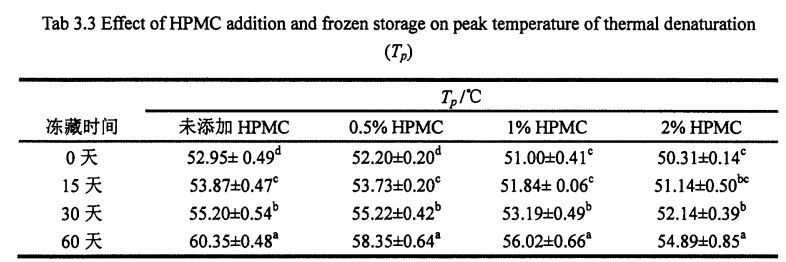
Nîşe: Di heman şêwazê de tîpên piçûk ên xwerû di heman rengî de, ji bilî vê yekê (1990) Therefore, more hydrophobic groups in gluten were exposed during freezing, and HPMC could effectively stabilize the molecular conformation of gluten.
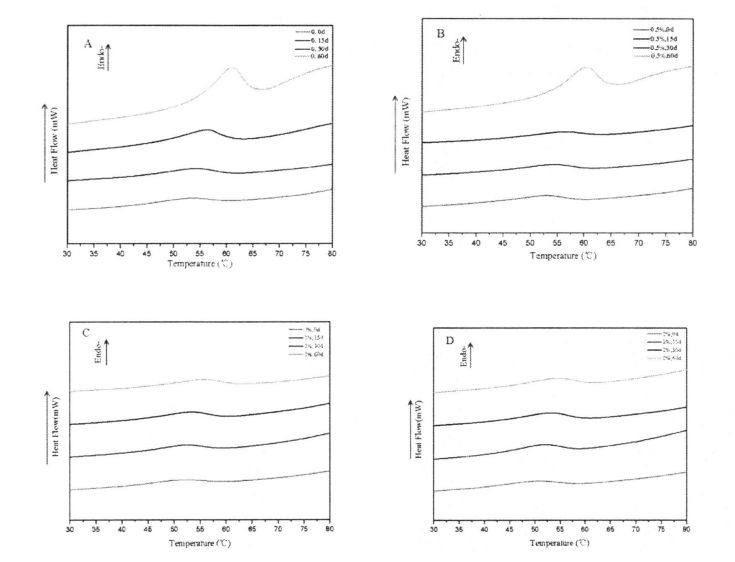
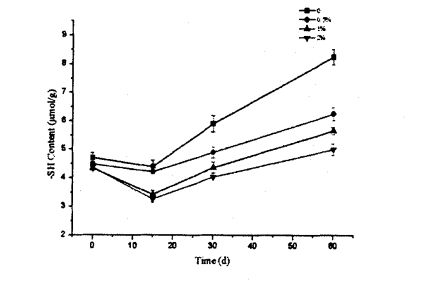
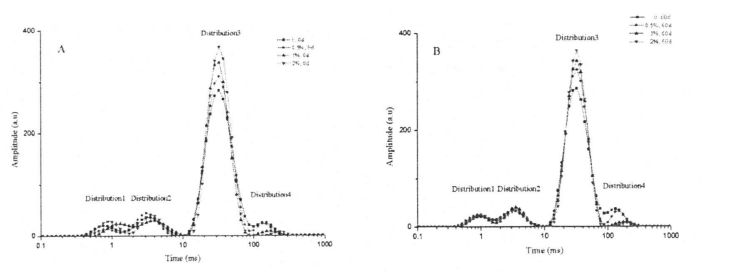
Comparing the wet gluten doughs with different addition amounts of HPMC stored in frozen storage for 60 days and unfrozen storage respectively, it was found that the total distribution area of T21 and T24 did not show a significant difference, indicating that the addition of HPMC did not significantly increase the relative amount of bound water. content, which may be due to the fact that the main water-binding substances (gluten protein with a small amount of starch) were not significantly changed by the addition of a small amount of HPMC. Ji hêla din ve, bi berhevkirina deverên belavkirinê yên T21 û T24 ya Gluten-ê ya şilandî ya ku ji bo demên hilanînê yên bêkêmasî yên ku di dema pêvajoya hilgirtinê ya zindî de lê zêde dibe, û bandorek neyînî li ser jîngehê heye. Guhertin kêmtir hestiyar û kêmtir bandor in.
Lêbelê, di asta û qada belavkirina T23 de cûdahiyên Gluten ên T23 hebûn û bi zêdebûna HPMC-ê ya cûda ne, û bi zêdebûna belavkirinê û qada belavkirina T23 ve zêde bûn (Fig. 3.4). This change shows that HPMC can significantly increase the relative content of limited water, and it is positively correlated with the added amount within a certain range. In addition, with the extension of freezing storage time, the height and area of T23 distribution of the wet gluten mass with the same HPMC content decreased to varying degrees. Ji ber vê yekê, ligel ava girêdanê, ava sînorkirî bandorek sînorkirî li ser hilanîna azadkirinê nîşan da. Hisê nazik. Ev meyl pêşniyar dike ku danûstendina di navbera matrixê ya proteîna gluten û ava vexwarinê qels dibe. This may be because more hydrophobic groups are exposed during freezing, which is consistent with the thermal denaturation peak temperature measurements. In particular, the height and area of the T23 distribution for the wet gluten mass with 2% HPMC addition did not show a significant difference. This indicates that HPMC can limit the migration and redistribution of water, and can inhibit the transformation of the water state from the restricted state to the free state during the freezing process.
In addition, the height and area of the T24 distribution of the wet gluten mass with different contents of HPMC were significantly different (Fig. 3.4, A), and the relative content of free water was negatively correlated with the amount of HPMC added. This is just the opposite of the Dang distribution. Therefore, this variation rule indicates that HPMC has water holding capacity and converts free water to confined water. However, after 60 days of freezing, the height and area of T24 distribution increased to varying degrees, which indicated that the water state changed from restricted water to free-flowing state during the freezing process. This is mainly due to the change of the gluten protein conformation and the destruction of the "layer" unit in the gluten structure, which changes the state of the confined water contained in it. Although the content of freezable water determined by DSC also increases with the extension of freezing storage time, however, due to the difference in the measurement methods and characterization principles of the two, the freezable water and free water are not completely equivalent. Ji bo girseya gluten a şilandî bi 2% HPMC re, piştî 60 rojan ji çar belavkirinan cûdahiyên girîng nîşan neda, ku hpmc dikare bi awayekî avakirina ava vexwarinê û danûstendina xwe bi gluten ve bigire. and stable liquidity.
3.3.5 Bandorên Mezinahiya HPMC-ê û dema hilanînê ya li ser strukturên duyemîn ên proteîna gluten
Bi gelemperî, strukturên duyemîn ên proteîn di çar celeb, α-spiral, β-qefilandin, β-corn û curlên xwerû de têne dabeş kirin. The most important secondary bonds for the formation and stabilization of the spatial conformation of proteins are hydrogen bonds. Ji ber vê yekê, Denatura Proteîn pêvajoyek ji bo şikandina bondê ya hîdrojenê û guhertinên lihevhatî ye.
Fourier transform infrared spectroscopy (FT-IR) has been widely used for high-throughput determination of the secondary structure of protein samples. The characteristic bands in the infrared spectrum of proteins mainly include, amide I band (1700.1600 cm-1), amide II band (1600.1500 cm-1) and amide III band (1350.1200 cm-1). Correspondingly, the amide I band the absorption peak originates from the stretching vibration of the carbonyl group (-C=O-.), the amide II band is mainly due to the bending vibration of the amino group (-NH-) [1271], and the amide III band is mainly due to the amino bending vibration and .CN-.Synchronous compound vibration in the same plane of bond Vibration dirêjkirin, û xwedî hestiyariyek bilind e ku di strukturên navîn ên proteîn de [128'1291. Although the above three characteristic bands are all characteristic infrared absorption peaks of proteins, the specific In other words, the absorption intensity of amide II band is lower, so the semi-quantitative accuracy of protein secondary structure is poor; while the peak absorption intensity of amide I band is higher, so many researchers analyze the secondary structure of protein by this band [ 1301, but the absorption peak of water and the amide I band are overlapped at about 1640 cm. 1 wavenumber (overlapped), ku di encamê de rastiya encaman bandor dike. Therefore, the interference of water limits the determination of the amide I band in protein secondary structure determination. In this experiment, in order to avoid the interference of water, the relative contents of four secondary structures of gluten protein were obtained by analyzing the amide III band. Peak position (wavenumber interval) of

Figure 3.5 is the infrared spectrum of the amide III band of gluten protein added with different contents of HPMC for 0 days after being frozen for 0 days after deconvolution and fitting of the second derivative. (2001) applied the second derivative to fit the deconvoluted peaks with similar peak shapes [1321]. Ji bo hejmartina naveroka têkildar a her strukturên navîn, maseya 3.5 bi kurtahî naveroka relatorê ya çar çaremîn a proteîna gluten û pêlên cûda yên HPMC (Peak Area giştî / Peak).
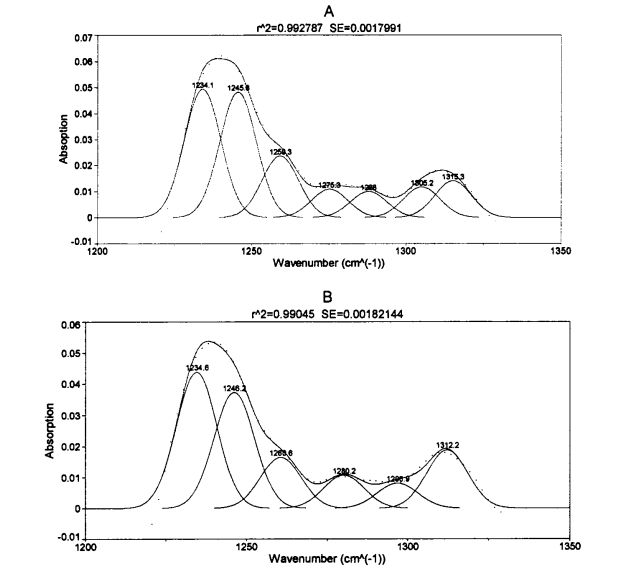
Note: A is the infrared spectrum of wheat gluten protein without adding HPMC for 0 days of frozen storage; B spektrika infrared a ku ji bo 0 rojan bi 2 rojan bi 2% HPMC zêde kir
Bi dirêjkirina dema hilanîna frozen, avahiya duyemîn a proteîna gluten bi additions cuda yên HPMC bi astên cihêreng guherîn. Ew dikare were dîtin ku hem hilanînê û hem jî zêdebûna hpmc li ser avahiya duyemîn a proteîna gluten bandorek heye. Tevî ku hpmc zêde kir, B. Struktura palandî avahiya herî serdest e, ji% 60 berpirsiyar e. After 60 days of frozen storage, add 0%, OB Gluten of 5% and 1% HPMC. Naveroka têkildar a folds ji hêla 3.66%, 1.87% û 1.16%, bi rêzdarî, ya ku ji hêla Meziani et al re ve hatî destnîşankirin, zêde bû. (2011) [l33J]. However, there was no significant difference during frozen storage for gluten supplemented with 2% HPMC. In addition, when frozen for 0 days, with the increase of HPMC addition, p. The relative content of folds increased slightly, especially when the addition amount was 2%, p. The relative content of folds increased by 2.01%. D. The folded structure can be divided into intermolecular p. Folding (caused by aggregation of protein molecules), antiparallel p. Folded and parallel p. Sê Substrucures têne qewirandin, û zehmet e ku meriv diyar bike ka kîjan substructure di pêvajoya serbestberdanê de pêk tê
changed. Some researchers believe that the increase in the relative content of the B-type structure will lead to an increase in the rigidity and hydrophobicity of the steric conformation [41], and other researchers believe that p. Zêdebûna avahiyên qewimîn ji ber beşek ji avakirina nû ya β-fold bi qelskirina hêza struktural re tê domandin. β- The increase in the folded structure indicates that the protein is polymerized through hydrophobic bonds, which is consistent with the results of the peak temperature of thermal denaturation measured by DSC and the distribution of transverse relaxation time measured by low-field nuclear magnetic resonance. Protein Denaturation. Ji aliyekî din ve, 0.5%, 1% û 2% HPMC Gluten Proteîn α-çirûsk. The relative content of helix increased by 0.95%, 4.42% and 2.03% respectively with the prolongation of freezing time, which is consistent with Wang, et a1. (2014) encamên wiha dîtin [134]. 0 of gluten without added HPMC. There was no significant change in the relative content of helix during the frozen storage process, but with the increase of the addition amount of freeze for 0 days. There were significant differences in the relative content of α-whirling structures.
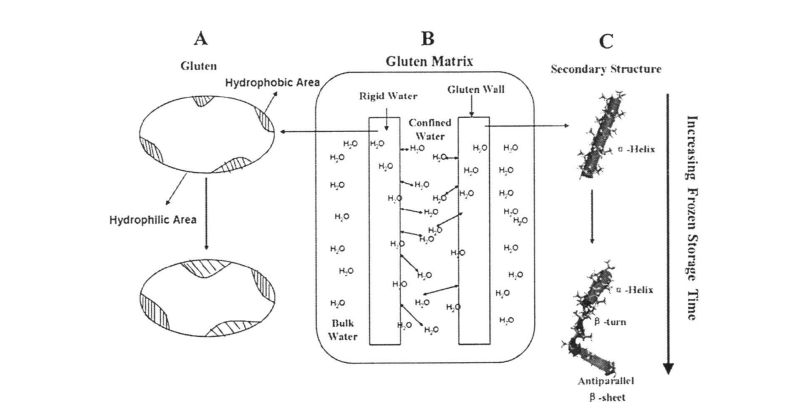
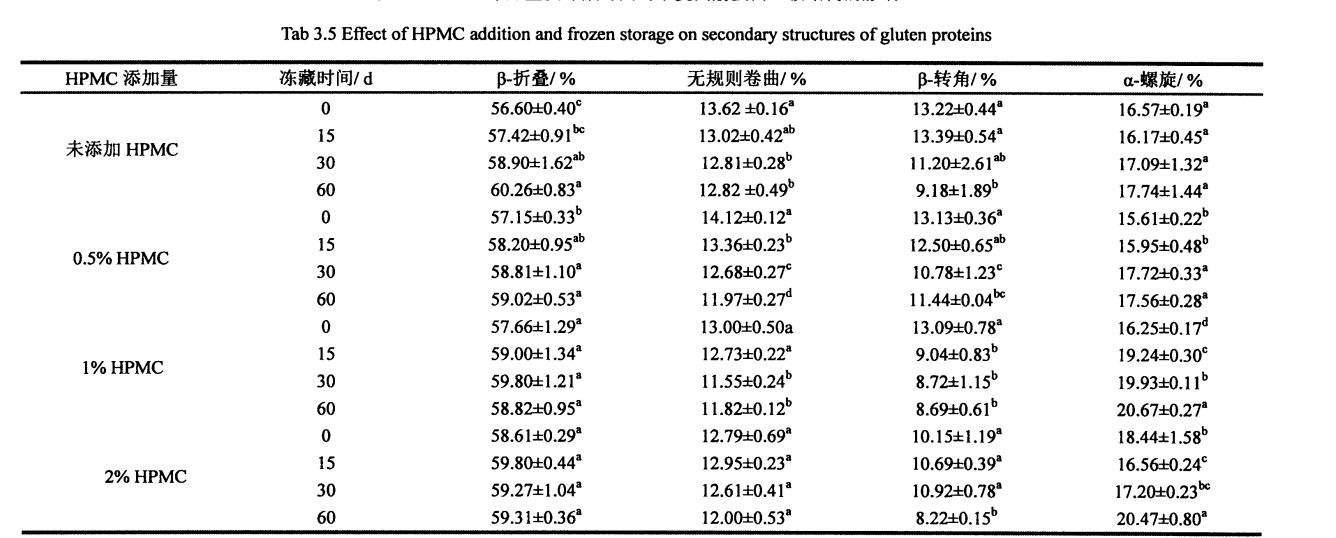
Hemî nimûneyên bi dirêjkirina dema serbestkirina demê, p. The relative contents of the corners were significantly reduced. This shows that β-turn is very sensitive to freezing treatment [135. 1361], and whether HPMC is added or not has no effect. WELLNER, ET A1. (2005) proposed that the β-chain turn of gluten protein is related to the β-turn space domain structure of the glutenin polypeptide chain [l 37]. Except that the relative content of random coil structure of gluten protein added with 2% HPMC had no significant change in frozen storage, the other samples were significantly reduced, which may be caused by the extrusion of ice crystals. Wekî din, gava ku ji bo 0 rojan, naveroka têkel a α-helix, struktura β-ag-a-zivirî ya proteîna gluten bi 2% HPMC ve hatî zêdekirin ji wan proteîna gluten bêyî HPMC-ê girîng bû. This may indicate that there is an interaction between HPMC and gluten protein, forming new hydrogen bonds and then affecting the conformation of the protein; or HPMC absorbs the water in the pore cavity of the protein space structure, which deforms the protein and leads to more changes between the subunits. nêzîkî. The increase of the relative content of β-sheet structure and the decrease of the relative content of β-turn and α-helix structure are consistent with the above speculation. During the freezing process, the diffusion and migration of water and the formation of ice crystals destroy the hydrogen bonds that maintain the conformational stability and expose the hydrophobic groups of proteins. In addition, from the perspective of energy, the smaller the energy of the protein, the more stable it is. Di germahiya kêm de, tevgera xweseriyê (paldankî û veberhênanê) molekulên proteîn bixweber pêşve diçe û rê dide guhertinên lihevhatî.
Protein molecules include both hydrophilic and hydrophobic groups. Generally, the protein surface is composed of hydrophilic groups, which can bind water through hydrogen bonding to form a hydration layer to prevent protein molecules from agglomerating and maintain their conformational stability. The interior of the protein contains more hydrophobic groups to form and maintain the secondary and tertiary structure of the protein through the hydrophobic force. Denaturation of Proteins bi gelemperî bi eşkerekirina komên hîdrofobîk û zêdebûna hîdrofobîkbûna erdê zêde dibe.

HPMC dikare bi komên hîdrofîlîkî re li ser rûyê proteînê bi navgîniya rûkên navîn re hevber bike, bi vî rengî li ser taybetmendiyên erdê yên proteînê biguhezîne, dema ku sînorkirina komên hîdrofobîk (Table 3.6).
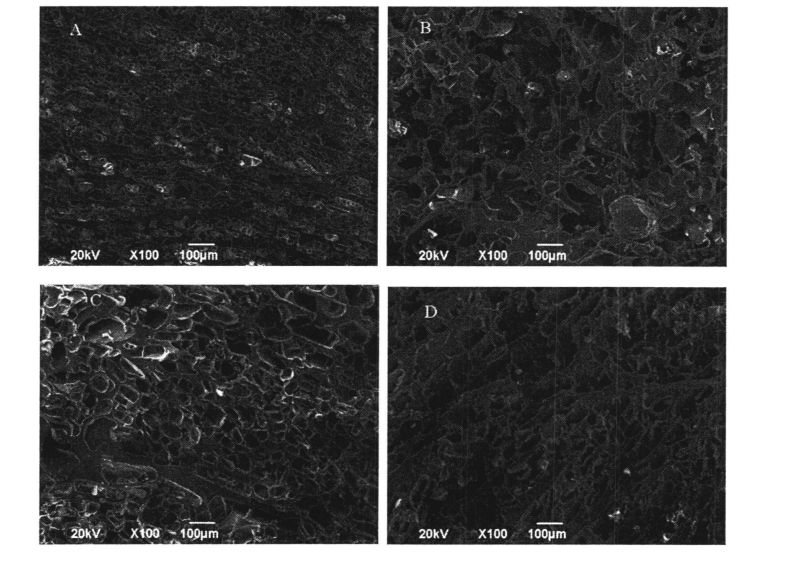
Fig 5 wêneyên sem ên mîkrostructura gluten, (a) gluten dough bi 0% hpmc
Nîşe: A Microstructure of Tora Gluten bêyî ku HPMC zêde bike û ji bo 0 rojan zêde bike; B Microstructure ya tora gluten e bêyî ku 60 roj zêde bike HPMC û bi lez û bez; C is the microstructure of gluten network with 2% HPMC added and frozen for 0 days :D is the gluten network microstructure with 2% HPMC added and frozen for 60 days
Piştî 60 rojan de hilanîna berfê, mîkrostructure ya girseya gluten ya şilandî bêyî HPMC bi girîngî hate guhertin (Fig. 3.7, AB). Di 0 rojan de, mîkrostrasên gluten bi 2% an 0% HPMC Shapeêwaza tevahî, mezin nîşan da
Small approximate porous sponge-like morphology. However, after 60 days of frozen storage, the cells in the gluten microstructure without HPMC became larger in size, irregular in shape, and unevenly distributed (Fig. 3.7, A, B), mainly due to the This is caused by the fracture of the "wall", which is consistent with the measurement results of the free thiol group content, that is, during the freezing process, the ice crystal squeezes and breaks the disulfide bond, which affects the strength and integrity of the structure. As reported by Kontogiorgos & Goff (2006) and Kontogiorgos (2007), the interstitial regions of the gluten network are squeezed due to freeze-shrinkage, resulting in structural disruption [138. 1391]. In addition, due to dehydration and condensation, a relatively dense fibrous structure was produced in the spongy structure, which may be the reason for the decrease in free thiol content after 15 days of frozen storage, because more disulfide bonds were generated and frozen storage. Struktura gluten ji bo demek kurt, ku bi Wang, ET A1 re têkildar bû, zirarê negirtî bû. (2014) Fenomena wiha çavdêrî [134]. At the same time, the destruction of the gluten microstructure leads to freer water migration and redistribution, which is consistent with the results of low-field time-domain nuclear magnetic resonance (TD-NMR) measurements. Some studies [140, 105] reported that after several freeze-thaw cycles, the gelatinization of rice starch and the structural strength of the dough became weaker, and the water mobility became higher. Nonetheless, after 60 days of frozen storage, the microstructure of gluten with 2% HPMC addition changed less, with smaller cells and more regular shapes than gluten without HPMC addition (Fig. 3.7, B, D). Vê yekê bêtir diyar dike ku HPMC dikare bi rengek têkbirina strukturên gluten bi recrystallization asteng bike.
This experiment investigated the rheology of wet gluten dough and gluten protein by adding HPMC with different contents (0%, 0.5%, 1% and 2%) during freezing storage (0, 15, 30 and 60 days). properties, thermodynamic properties, and effects of physicochemical properties. The study found that the change and redistribution of water state during the freezing storage process significantly increased the freezable water content in the wet gluten system, which led to the destruction of the gluten structure due to the formation and growth of ice crystals, and ultimately caused the processing properties of the dough to be different. Xirabûna kalîteya hilberê. The results of frequency scanning showed that the elastic modulus and viscous modulus of the wet gluten mass without adding HPMC decreased significantly during the freezing storage process, and the scanning electron microscope showed that its microstructure was damaged. The content of free sulfhydryl group was significantly increased, and its hydrophobic group was more exposed, which made the thermal denaturation temperature and surface hydrophobicity of gluten protein significantly increased. However, the experimental results show that the addition of I-IPMC can effectively inhibit the changes in the structure and properties of wet gluten mass and gluten protein during freezing storage, and within a certain range, this inhibitory effect is positively correlated with the addition of HPMC. This is because HPMC can reduce the mobility of water and limit the increase of the freezable water content, thereby inhibiting the recrystallization phenomenon and keeping the gluten network structure and the spatial conformation of the protein relatively stable. This shows that the addition of HPMC can effectively maintain the integrity of the frozen dough structure, thereby ensuring product quality.
Beşa 4 Bandorên HPMC-ê li ser struktur û taybetmendiyên starch di bin depoya berfê de
4.1 Destpêk
Starch zincîreyek polysaccharide bi glukozê wekî Monomer e. Key) Du celeb. From a microscopic point of view, starch is usually granular, and the particle size of wheat starch is mainly distributed in two ranges of 2-10 pro (B starch) and 25-35 pm (A starch). From the perspective of crystal structure, starch granules include crystalline regions and amorphous regions (je, non-crystalline regions), and the crystal forms are further divided into A, B, and C types (it becomes V-type after complete gelatinization). Bi gelemperî, herêma kristal ji Amyloppectin pêk tê û herêma amorfûr bi piranî ji amylose pêk tê. This is because, in addition to the C chain (main chain), amylopectin also has side chains composed of B (Branch Chain) and C (Carbon Chain) chains, which makes amylopectin appear "tree-like" in raw starch. The shape of the crystallite bundle is arranged in a certain way to form a crystal.
Starch is one of the main components of flour, and its content is as high as about 75% (dry basis). At the same time, as a carbohydrate widely present in grains, starch is also the main energy source material in food. In the dough system, starch is mostly distributed and attached to the network structure of gluten protein. Di dema pêvajoyê û hilanînê de, stêran bi gelemperî di bin gerdûnî û qonaxên pîrbûnê de derbas dibin.
Pir lêkolînan destnîşan kir ku hêza gel a pasta stûyê kêm dibe, ew di temenê de hêsan e, û kalîteya wê di bin şertê rizgarkirina hilanînê de, mîna Canet, et A1 xirab dibe. (2005) Bandora serbestberdana germahiya li ser kalîteya paqijkirina patato ya potato; Ferrero, ET A1. (1993) investigated the effects of freezing rate and different types of additives on the properties of wheat and corn starch pastes [151-156]. However, there are relatively few reports on the effect of frozen storage on the structure and properties of starch granules (native starch), which needs to be further explored. Frozen dough (excluding pre-cooked frozen dough) is in the form of ungelatinized granules under the condition of frozen storage. Therefore, studying the structure and structural changes of native starch by adding HPMC has a certain effect on improving the processing properties of frozen dough. mane.
In this experiment, by adding different HPMC contents (0, 0.5%, 1%, 2%) to the starch suspension, the amount of HPMC added during a certain freezing period (0, 15, 30, 60 days) was studied. li ser strukturên stêrkan û bandora wê ya gelatinî ya xwezayê.
4.2 Materyal û rêbazên ezmûnî
Wheat Starch Binzhou Zhongyu Food Co., Ltd.; HPMC Aladdin (Shanghai) Kîmyewî Reagent Co., Ltd .;
HH germahiya germahiya dîjîtal a dîjîtal
Bsal24 Balansa Elektronîkî
Discovery R3 Rotacion RheTer
Q. 200 Calorimeter Scanning Cûdahî
Çêker
Hengfi Hengfeng Amûrên Dermanî Co., Ltd.
Shanghai Yiheng Science Science Instrument Co., Ltd.
Pargîdaniya Amerîkî TA
Pargîdaniya Amerîkî TA
Rigaku Manufacturer Co., Ltd.
Hengfi Hengfeng Amûrên Dermanî Co., Ltd.
Weigh 1 g of starch, add 9 mL of distilled water, fully shake and mix to prepare a 10% (w/w) starch suspension. Dûv re çareseriya nimûneyê bicîh bikin. 18 ℃ refrigerator, frozen storage for 0, 15 d, 30 d, 60 d, of which 0 day is the fresh control. Add 0.5%, 1%, 2% (w/w) HPMC instead of the corresponding quality starch to prepare samples with different addition amounts, and the rest of the treatment methods remain unchanged.
Nimûneyên jorîn bi hev re hatine dermankirin, bi 4 ° C li 4 ° C ji bo 4 h.
(1) Taybetmendiyên GELATINIZAT STARCH
Di vê ezmûnê de, reyek li şûna viscometer zûtir hate bikar anîn da ku taybetmendiyên gelatinî yên stêran pîvandin. Bae et A1 binihêrin. (2014) Method [1571] bi guherînên piçûktir. The specific program parameters are set as follows: use a plate with a diameter of 40 mill, the gap (gap) is 1000 mm, and the rotation speed is 5 rad/s; I) li 50 ° C ji bo 1 hûrdeman incubate; II) li 5. C / Min ji 95 ° C germ dibe; iii) kept at 95°C for 2.5 min, iv) then cooled to 50°C at 5°C/min; v) lastly held at 50°C for 5 min.
Solutionareseriya nimûneyê ya 1.5 ML bikişînin û wê li ser qonaxa nimûneya Rheometer-ê zêde bikin, û wextê (min) bistînin (pa s) û germahiya (° C) û germahiya starchînasyona starchînasyonê. According to GB/T 14490.2008 [158], the corresponding gelatinization characteristic indicators—gelatinization peak viscosity (field), peak temperature (Ang), minimum viscosity (high), final viscosity (ratio) and decay value (Breakdown) are obtained. Value, BV) and regeneration value (Setback Value, SV), wherein, decay value = peak viscosity - minimum viscosity; setback value = final viscosity - minimum viscosity. Each sample was repeated three times.
(2) Testa Flow ya Steady ya Paste Starch
The above gelatinized starch paste was subjected to the Steady Flow Test, according to the method of Achayuthakan & Suphantharika [1591, the parameters were set to: Flow Sweep mode, stand at 25°C for 10 min, and the shear rate scan range was 1) 0.1 S one. 100s ~, 2) 100s. 0.1 S ~, daneyên di moda logarithmîkî de têne berhev kirin, û 10 xalên daneyê têne tomarkirin, û di dawiyê de rêjeya şilandî (viscosity, pa shear (viscosity, pa · s) Bi eslê xwe 8.0 bikar bînin da ku bicîhkirina nêçîrvanê ya ne-linear bikin û hevsengiya hêzê (pa · s) biparêzin, û n.
2.5 g of amyloid hildin û wê bi ava distilandî di nav rêza 1: 2 de tevlihev bikin da ku şîrê starch bikin. Ji bo 15 d, 30 d, û 60 d, li 18 ° C bisekinin. 0.5, 1, 2% HPMC (w / w) Zêde bikin da ku stêrka heman kalîteyê biguhezînin, û rêbazên din ên amadekirinê bê guhertin. After the freezing treatment is completed, take it out, equilibrate at 4 °C for 4 h, and then thaw at room temperature until it is tested.
(3) Hêza Gel Starch (hêza gel)
Pêlek petrolatum bi rengek sivik hate li ser milê stûyê ku li jor hatî bidestxistin da ku di dema ezmûnên paşê de ji zirara avê dûr bixe. Referring to the Abebe & Ronda method [1601], an oscillatory strain sweep was firstly performed to determine the Linear Viscoelasticity Region (LVR), the strain sweep range was 0.01-100%, the frequency was 1 Hz, and the sweep was started after standing at 25 °C for 10 min.
Dûv re, frequency oscillation, mîqdara hişk (birrîna) li 0.1% saz bikin (li gorî encamên sweet sweep), û rêzika frekansê li O. 1 ji 10 Hz saz bikin. Her nimûneyek sê caran hate dubare kirin.
Piştî ku dema dermankirina berfirehkirina dema azadkirinê, nimûn hatin derxistin, bi tevahî hate avêtin, û di 40 ° C de ji bo 48 h. Finally, it was ground through a 100-mesh sieve to obtain a solid powder sample for use (suitable for XRD testing). See Xie, et a1. (2014) method for sample preparation and determination of thermodynamic properties '1611, weigh 10 mg of starch sample into a liquid aluminum crucible with an ultra-micro analytical balance, add 20 mg of distilled water in a ratio of 1:2, press and seal it and place it at 4 °C In the refrigerator, equilibrated for 24 h. Li 18 ° C (0, 15, 30 û 60 rojan bisekinin). 0.5%, 1%, 2% (w / w) HPMC zêde bike da ku hûn qalîteya starçeyê ya têkildar biguhezînin, û rêbazên amadekar ên din jî bê guhertin. Piştî ku dema hilanîna azadkirinê qediya, li 4 ° C 4 h.
(3) destnîşankirina germahiya gelatinîzasyonê û guhertina entalpy
4.2.3.7 Daneyên analîz û pêvajoyê
All experiments were repeated at least three times unless otherwise specified, and the experimental results were expressed as mean and standard deviation. SPSS statîstîka 19 ji bo analîzkirina variance (analîzkirina variance, anova) bi astek girîng a 0.05-an hate bikar anîn; Charts Correlation bi Origin 8.0 bi kar anîn.
According to GB 50093.2010, GB/T 5009.9.2008, GB 50094.2010 (78-s0), the basic components of wheat starch - moisture, amylose/amylopectin and ash content were determined. Encam di Tabloya 4 de têne nîşandan. 1 destnîşan kirin.

4.2 Effects of HPMC POUCTION HPMC LOUND HEM AND JI BO PROCTIONSNGEHA GELATINIZA WHEAT STARCHEAT
Stûna stûyê ku bi hûrguliyek diyarkirî di rêjeyek germbûnê de tê germ kirin da ku stêrka Gelatinized bibe. Piştî destpêkirina gelatinize, ji ber berfirehkirina starm, û viscosity bi berdewamî zêde dibe. Piştra, rûkulên granulê û viscosity kêm dibe. Dema ku paste di rêjeyek germbûnê de tê germ kirin, paste dê gel bibe, û nirxa viscosity dê zêde bibe. The viscosity value when it is cooled to 50 °C is the final viscosity value (Figure 4.1).
Table 4.2 Li ser gelek nîşanên girîng ên gelatinîbûna starchînasyonê, di nav de viscosity peakê ya girîng, viscosity ya herî kêm, viscosity ya dawîn, nirxa nirxê û nirxê ya hpmc û nirxandina li ser zeviya starch. bandorên taybetmendiyên kîmyewî. The experimental results show that the peak viscosity, the minimum viscosity and the final viscosity of starch without frozen storage increased significantly with the increase of HPMC addition, while the decay value and recovery value decreased significantly. Specifically, the peak viscosity gradually increased from 727.66+90.70 CP (without adding HPMC) to 758.51+48.12 CP (adding 0.5% HPMC), 809.754-56.59 CP (adding 1 %HPMC), and 946.64+9.63 CP (adding 2% HPMC); the minimum viscosity was increased from 391.02+18.97 CP (blank not adding) to 454.95+36.90 (adding O .5% HPMC), 485.56+54.0.5 (add 1% HPMC) and 553.03+55.57 CP (add 2% HPMC); Viscosity Dawîn ji 794.62.412.84 CP (bêyî zêdekirina HPMC) ji 882.24 ± 22.40.1.15 zêde kir (zêde kirin 1% hpmc) û 910.884-34.57 CP however, the attenuation value gradually decreased from 336.644-71.73 CP (without adding HPMC) to 303.564-11.22 CP (adding 0.5% HPMC), 324.19±2.54 CP (Add
Bi 1% HPMC) û 393.614-45.94 CP (bi 2% HPMC) ve ji 403.60 + 6.13 CP (bêyî HPMC) ji 427.484-41.39 CP (15 HPMC zêde kir) û 357.85 + 21.00 CP (2% HPMC zêde kir). This and the addition of hydrocolloids such as xanthan gum and guar gum obtained by Achayuthakan & Suphantharika (2008) and Huang (2009) can increase the gelatinization viscosity of starch while reducing the retrogradation value of starch. This may be mainly because HPMC acts as a kind of hydrophilic colloid, and the addition of HPMC increases the gelatinization peak viscosity due to the hydrophilic group on its side chain which makes it more hydrophilic than starch granules at room temperature. In addition, the temperature range of the thermal gelatinization process (thermogelation process) of HPMC is larger than that of starch (results not shown), so that the addition of HPMC can effectively suppress the drastic decrease in viscosity due to the disintegration of starch granules. Ji ber vê yekê, herî kêm viscosity û viscosity ya dawîn a gelatina starch hêdî hêdî bi zêdebûna naveroka HPMC re zêde bûn.
Ji aliyekî din ve, dema ku mîqdara HPMC zêde bû, viscosity, viscosity herî kêm, viscosity ya dawîn, nirxa hilweşînê û paşnavkirina starch-ê bi dirêjkirina dema hilanînê re zêde bû. Bi taybetî, pezê pezê sekinandina stûyê bêyî zêdekirina HPMC ji 727.66 ± 90.66 ± adding 0.5 The peak viscosity of starch suspension with %HPMC increased from 758.514-48.12 CP (freezing for 0 days) to 1415.834-45.77 CP (freezing for 60 days); starch suspension with 1% HPMC added The peak viscosity of the starch liquid increased from 809.754-56.59 CP (freeze storage for 0 days) to 1298.19-±78.13 CP (frozen storage for 60 days); while the starch suspension with 2% HPMC CP added Gelatinization peak viscosity from 946.64 ± 9.63 CP (0 days frozen) increased to 1240.224-94.06 CP (60 days frozen). At the same time, the lowest viscosity of starch suspension without HPMC was increased from 391.02-41 8.97 CP (freezing for 0 days) to 556.77±29.39 CP (freezing for 60 days); adding 0.5 The minimum viscosity of the starch suspension with %HPMC increased from 454.954-36.90 CP (freezing for 0 days) to 581.934-72.22 CP (freezing for 60 days); the starch suspension with 1% HPMC added The minimum viscosity of the liquid increased from 485.564-54.05 CP (freezing for 0 days) to 625.484-67.17 CP (freezing for 60 days); while the starch suspension added 2% HPMC CP gelatinized The lowest viscosity increased from 553.034-55.57 CP (0 days frozen) to 682.58 ± 20.29 CP (60 days frozen).

Visyona dawîn a rawestandina starchê bêyî zêdekirina HPMC ji 794.62 ± 12.84 ± 12.84 ji bo 0 rojan zêde bû) heya 1413.59 ± Viscosity Peak ji rawestandina stûyê ji 882.24 ± 22.40 CP (ji bo 0 rojan hilanînê) ji 1322.86 ± 36.86 ± 36.23 CP (ji bo 60 rojan hilanîn) the peak viscosity of starch suspension added with 1% HPMC The viscosity increased from 846.04 ± 12.66 CP (frozen storage 0 days) to 1291.94 ± 88.57 CP (frozen storage for 60 days); and the gelatinization peak viscosity of starch suspension added with 2% HPMC increased from 91 0.88 ± 34.57 CP
(Derketina Frozen ji bo 0 rojan) heya 1198.09 ± 41.15 CP (ji bo 60 rojan hilanînê Frozen) zêde bû. Correspondingly, the attenuation value of starch suspension without adding HPMC increased from 336.64 ± 71.73 CP (frozen storage for 0 days) to 1027.67 ± 38.72 CP (frozen storage for 60 days); adding 0.5 The attenuation value of starch suspension with %HPMC increased from 303.56±11.22 CP (frozen storage for 0 days) to 833.9±26.45 CP (frozen storage for 60 days); starch suspension with 1% HPMC added The attenuation value of the liquid was increased from 324.19 ± 2.54 CP (freezing for 0 days) to 672.71 ± 10.96 CP (freezing for 60 days); while adding 2% HPMC,the attenuation value of the starch suspension increased from 393.61 ± 45.94 CP (freezing for 0 days) to 557.64 ± 73.77 CP (freezing for 60 days); while the starch suspension without HPMC added The retrogradation value increased from 403.60 ± 6.13 C
P (Stargeha Frozen ji bo 0 rojan) heta 856.38 ± 16.20 CP (ji bo 60 rojan hilanînê Frozen); the retrogradation value of starch suspension added with 0.5% HPMC increased from 427 .29±14.50 CP (frozen storage for 0 days) increased to 740.93±35.99 CP (frozen storage for 60 days); Nirxa paşvekişandinê ya sekinandina starchê ku bi 1% HPMC ji 360.48 ± 41 zêde bû. 39 CP (Stargeha Frozen ji bo 0 rojan) zêde bû 666.46 ± 21.40 ± 21.40 CP (ji bo 60 rojan hilanîn); Dema ku nirxa paşvekişandinê ya suspension starch bi 2% HPMC ve hatî zêdekirin ji 357.85 ± 21.85 ± 21,00 cp (ji bo 60 rojan hilanînê). 0 roj) heta 515.51 ± 20.86 CP (60 roj şûnda) zêde bû.
It can be seen that with the prolongation of freezing storage time, the starch gelatinization characteristics index increased, which is consistent with Tao et a1. f2015) 1. Consistent with the experimental results, they found that with the increase of the number of freeze-thaw cycles, the peak viscosity, minimum viscosity, final viscosity, decay value, and retrogradation value of starch gelatinization all increased to different degrees [166J]. Ev bi piranî ji ber ku di pêvajoya hilanîna amorfûr (herêma amorfûr) de ye (qonaxa bingehîn) fenomen, û di encama sekinandina starchê de belav dibe, di encamê de di encama viscosity ya stêrkan de belav dibe gelatinization, and an increase in the related attenuation value and retrogradation value. However, the addition of HPMC inhibited the effect of ice crystallization on starch structure. Therefore, the peak viscosity, minimum viscosity, final viscosity, decay value and retrogradation rate of starch gelatinization increased with the addition of HPMC during frozen storage. increase and decrease sequentially.

Bandora rêjeya hişk a li ser viscosity zelal (viscosity shear) ya liquidê ji hêla testa bihayê ya domdar ve hate lêkolîn kirin, û avahiya maddî û taybetmendiyên liquidê li gorî xwe hate destnîşan kirin. Table 4.3 lists the equation parameters obtained by nonlinear fitting, that is, the consistency coefficient K and the flow characteristic index D, as well as the influence of the addition amount of HPMC and the freezing storage time on the above parameters K gate.


However, with the prolongation of freezing storage time, the values of K and n increased to different degrees, among which the value of K increased from 78.240 ± 1.661 Pa·sn (unadded, 0 days) to 95.570 ± 1, respectively. 2.421 Pa·sn (no addition, 60 days), increased from 65.683±1.035 Pa ·S n (addition of O. 5% HPMC, 0 days) to 51.384±1.350 Pa ·S n (Add to 0.5% HPMC, 60 days), increased from 43.122±1.047 Pa ·sn (adding 1% HPMC, 0 days) to 56.538±1.378 Pa ·sn (adding 1% HPMC, 60 days) ), and increased from 13.926 ± 0.330 Pa ·sn (adding 2% HPMC, 0 days) to 16.064 ± 0.465 Pa ·sn (adding 2% HPMC, 60 days); 0.277 ± 0.011 (without adding HPMC, 0 days) rose to O. 334±0.014 (no addition, 60 days), increased from 0.310±0.009 (0.5% HPMC added, 0 day) to 0.336±0.014 (0.5% HPMC added, 60 days), from 0.323 ± 0.013 (add 1% HPMC, 0 days) to 0.340 ± 0.013 (add 1% HPMC, 60 days), and from 0.431 ± 0.013 (add 1% HPMC, 60 days) 2% HPMC, 0 days) to 0.404+0.020 (add 2% HPMC, 60 days). By comparison, it can be found that with the increase of the addition amount of HPMC, the change rate of K and Knife value decreases successively, which shows that the addition of HPMC can make the starch paste stable under the action of shearing force, which is consistent with the measurement results of starch gelatinization characteristics. hevhatî.
Sêvê Dînamî yê Dînamîk dikare bi rengek bi bandor nîşan bide viscoelasticity materyalê, û ji bo pasta starch, ev dikare were bikar anîn da ku hêza xwe ya gel (hêza gel) bikar bîne. Figure 4.3 Guherandinên modulusê hilanînê / Modulusê elastîk (G ') û Modulusê Modulus / Viscosity Modulus (G ") di bin şert û mercên lêpirsîna HPMC-ê ya cûda de nîşan dide.

Hêjeya 4.3 Bandora HPMC ya HPMC û hilanîna berfê li ser modulasyona elastîk û viscous paste
The starch gelatinization process is accompanied by the disintegration of starch granules, the disappearance of the crystalline region, and the hydrogen bonding between starch chains and moisture, the starch gelatinized to form a heat-induced (Heat. induced) gel with a certain gel strength. As shown in Figure 4.3, for starch without frozen storage, with the increase of HPMC addition, the G' of starch decreased significantly, while G" had no significant difference, and tan 6 increased (Liquid. 1ike), which shows that during the gelatinization process, HPMC interacts with starch, and due to the water retention of HPMC, the addition of HPMC reduces the water loss of starch during the gelatinization process. At the same time, Chaisawang & Suphantharika (2005) found that, adding guar gum and xanthan gum to tapioca starch, the G' of the starch paste also decreased [170]. In addition, with the extension of the freezing storage time, the G' of starch gelatinized decreased to different degrees. This is mainly because during the frozen storage process of starch, the amylose in the amorphous region of starch granules is separated to form damaged starch (Damaged Starch), which reduces the degree of intermolecular cross-linking after starch gelatinization and the degree of cross-linking after cross-linking. Stability and compactness, and the physical extrusion of ice crystals makes the arrangement of "micelles" (microcrystalline structures, mainly composed of amylopectin) in the starch crystallization area more compact, increasing the relative crystallinity of starch, and at the same time , resulting in insufficient combination of molecular chain and water after starch gelatinization, low extension of molecular chain (molecular chain mobility), and finally caused the gel strength of starch to decline. Lêbelê, bi zêdebûna zêdekirina HPMC, mezinahiya kêmbûna G 'hat tepisandin, û ev bandor bi zêdebûna HPMC re têkildar bû. This indicated that the addition of HPMC could effectively inhibit the effect of ice crystals on the structure and properties of starch under frozen storage conditions.
4.3.5 Bandorên Mezinahiya I-IPMC-ê û dema hilanînê ya birêkûpêk a li ser kapasîteya tîrêjê ya stêrka
Rêjeya tîrêjê ya stûyê dikare mezinahiya gelatinîzasyona starch û ava vexwarinê nîşan bide, û aramiya pasta stêran di bin şert û mercên centrifugal de. As shown in Figure 4.4, for starch without frozen storage, with the increase of HPMC addition, the swelling force of starch increased from 8.969+0.099 (without adding HPMC) to 9.282- -L0.069 (adding 2% HPMC), which shows that the addition of HPMC increases the swelling water absorption and makes starch more stable after gelatinization, which is consistent with encamnameya taybetmendiyên gelatînbûna starch. Lêbelê, bi dirêjkirina dema hilanîna berfireh, hêza tîrêjê ya stûyê kêm bû. Compared with 0 days of frozen storage, the swelling power of starch decreased from 8.969-a:0.099 to 7.057+0 after frozen storage for 60 days, respectively. .007 (no HPMC added), reduced from 9.007+0.147 to 7.269-4-0.038 (with O.5% HPMC added), reduced from 9.284+0.157 to 7.777 +0.014 (adding 1% HPMC), reduced from 9.282+0.069 to 8.064+0.004 (adding 2% HPMC). The results showed that the starch granules were damaged after freezing storage, resulting in the precipitation of part of the soluble starch and centrifugation. Therefore, the solubility of starch increased and the swelling power decreased. Digel vê yekê, piştî hilanîna stargehê, stûyê starchandî ya starch, aramiya avêtina avê kêm bû, û çalakiya hevbeş a her duyan jî hêza tîrêjê ya stêran kêm kir [1711]. Ji aliyekî din ve, bi zêdebûna zêdekirina HPMC, hilweşîna stûyê stûyê hêdî hêdî kêm bû, nîşan dide ku HPMC dikare di dema azadkirina stargehê de ya ku di dema hilanîna stargehê de hatî çêkirin kêm bike û asta zirarê ya granule ya starch kêm bike.
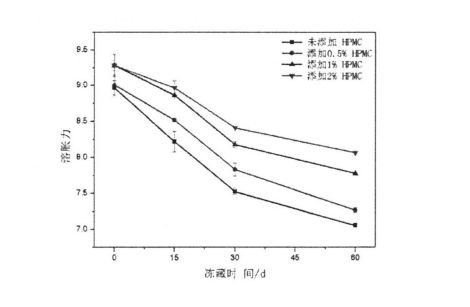
Gelatîzasyona stêrkan pêvajoyek thermodîmyayî ya kîmyewî ye. Therefore, DSC is often used to determine the onset temperature (Dead), peak temperature (To), end temperature (T p), and gelatinization enthalpy of starch gelatinization. (TC). Table 4.4 shows the DSC curves of starch gelatinization with 2% and without HPMC added for different freezing storage times.
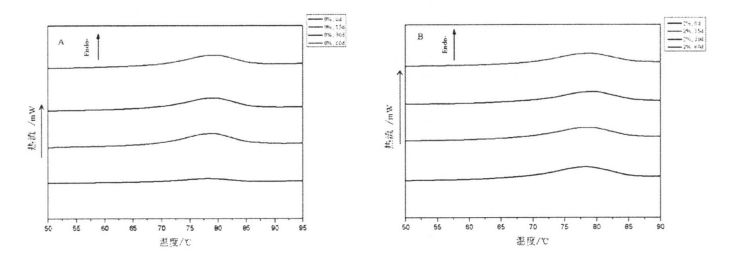
Nîşe: A DSC Curve of Starch bêyî 0, 15, 30 û 60 roj zêde dike: B 2% HPMC ji bo 0, 15, 30 û 60 rojan zêde kir
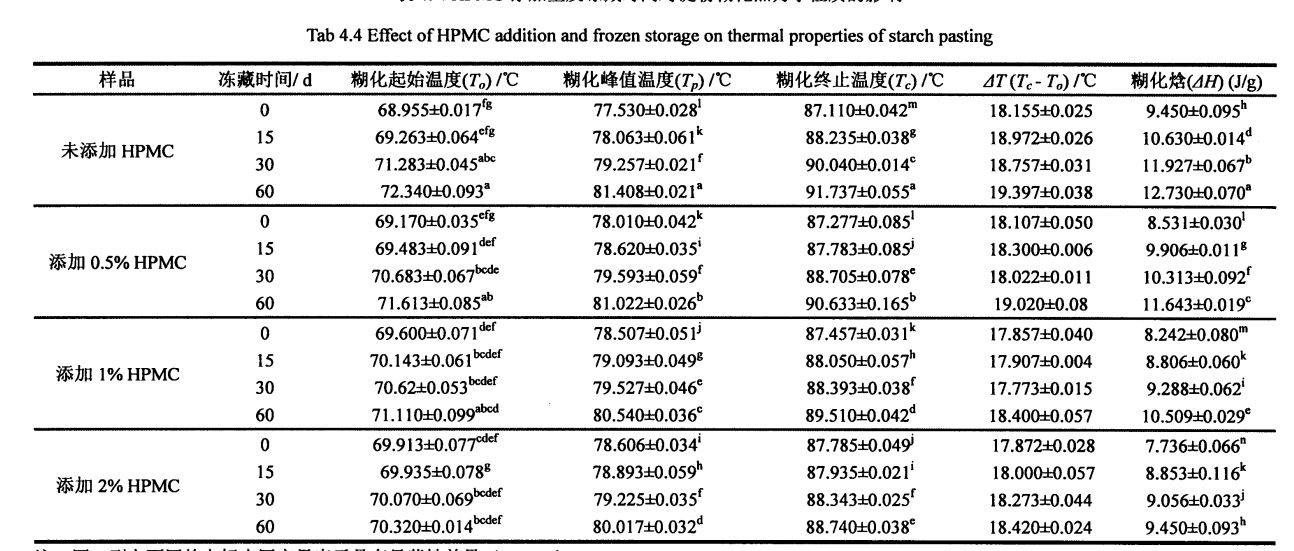
As shown in Table 4.4, for fresh amyloid, with the increase of HPMC addition, starch L has no significant difference, but increases significantly, from 77.530 ± 0.028 (without adding HPMC) to 78.010 ± 0.042 (add 0.5% HPMC), 78.507 ± 0.051 (add 1% HPMC), and 78.606 ± 0.034 (add 2% HPMC), but 4H is significant Decrease, from 9.450 ± 0.095 (without adding HPMC) to 8.53 ± 0.030 (adding 0.5% HPMC), 8.242A: 0.080 (adding 1% HPMC) and 7 .736 ± 0.066 (add 2% HPMC). This is similar to Zhou, et a1. (2008) dît ku lê zêde bike koloîdek hîdrofîlîk kêmbûna starchînzasyonê kêm kir û germahiya pezê Gelatinization Starch [172] zêde kir. This is mainly because HPMC has better hydrophilicity and is easier to combine with water than starch. Di heman demê de, ji ber ku sînorê germahiya mezin a pêvajoya gerdûnê ya bi lezgîn a HPMC, zêdekirina HPMC germahiya hewayê ya peşîn a stargehê zêde dike, dema ku gelatinization Enthalpy kêm dibe.
Ji aliyekî din ve, gelasyona starch ji, t p, tc, △ t û △ Hall bi dirêjkirina dema azadbûnê zêde bû. Specifically, starch gelatinization with 1% or 2% HPMC added had no significant difference after freezing for 60 days, while starch without or with 0.5% HPMC was added from 68.955±0.01 7 (frozen storage for 0 days) increased to 72.340 ± 0.093 (frozen storage for 60 days), and from 69.170 ± 0.035 (frozen storage for 0 days) to 71.613 ± 0.085 (frozen storage for 0 days) 60 days); after 60 days of frozen storage, the growth rate of starch gelatinization decreased with the increase of HPMC addition, such as starch without HPMC added from 77.530 ± 0.028 (frozen storage for 0 days) to 81.028. 408 ± 0.021 (frozen storage for 60 days), while the starch added with 2% HPMC increased from 78.606 ± 0.034 (frozen storage for 0 days) to 80.017 ± 0.032 (frozen storage for 60 days). days); in addition, ΔH also showed the same change rule, which increased from 9.450 ± 0.095 (no addition, 0 days) to 12.730 ± 0.070 (no addition, 60 days), respectively, from 8.450 ± 0.095 (no addition, 0 days) to 12.730 ± 0.070 (no addition, 60 days), respectively. 531 ± 0.030 (add 0.5%, 0 days) to 11.643 ± 0.019 (add 0.5%, 60 days), from 8.242 ± 0.080 (add 1%, 0 days) to 10.509 ± 0.029 (add 1%, 60 days), and from 7.736 ± O. 066 (2% addition, 0 days) rose to 9.450 ± 0.093 (2% addition, 60 days). The main reasons for the above-mentioned changes in the thermodynamic properties of starch gelatinization during the frozen storage process are the formation of damaged starch, which destroys the amorphous region (amorphous region) and increases the crystallinity of the crystalline region. Hevserokatiya herduyan bi xalîçeya starçeyê zêde dike, ku di encamê de dibe sedema zêdebûna nîşanên thermodînamîk ên wekî germahiya hewayê ya starch û germahiya hewayê ya starch û gelasyonê. However, through comparison, it can be found that under the same freezing storage time, with the increase of HPMC addition, the increase of starch gelatinization To, T p, Tc, ΔT and ΔH gradually decreases. It can be seen that the addition of HPMC can effectively maintain the relative stability of the starch crystal structure, thereby inhibiting the increase of the thermodynamic properties of starch gelatinization.
Figure 4.6. As shown in A, the positions of the starch crystallization peaks are located at 170, 180, 190 and 230, respectively, and there is no significant change in the peak positions regardless of whether they are treated by freezing or adding HPMC. Ev nîşan dide ku, wekî taybetmendiyek xwerû ya kristiya stûyê genimê, forma kristallandî dimîne.
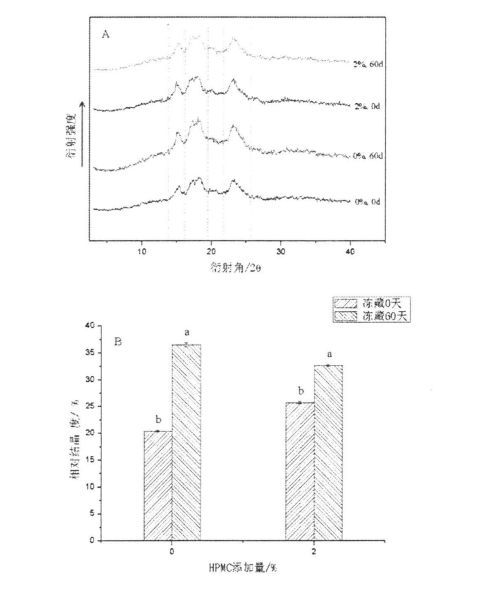
Hêjeya 4.6 Bandora HPMC-ê ya HPMC û hilanîna berfê li ser taybetmendiyên XRD
4.4 Bihayê Beşa
Starch is the most abundant dry matter in dough, which, after gelatinization, adds unique qualities (specific volume, texture, sensory, flavor, etc.) to the dough product. Since the change of starch structure will affect its gelatinization characteristics, which will also affect the quality of flour products, in this experiment, the gelatinization characteristics, flowability and flowability of starch after frozen storage were investigated by examining starch suspensions with different contents of HPMC added. Changes in rheological properties, thermodynamic properties and crystal structure were used to evaluate the protective effect of HPMC addition on starch granule structure and related properties. Encamên ceribandinê nîşan dan ku piştî 60 rojan de hilanînê ya starchînasyonê (vîzyona pez, viscosity ya herî kêm û nirxa retrobbûnê) ji ber zêdebûna berbiçav a stargeh û zêdebûna naveroka stêrka zirarê. The gelatinization enthalpy increased, while the gel strength of starch paste decreased significantly; however, especially the starch suspension added with 2% HPMC, the relative crystallinity increase and starch damage degree after freezing were lower than those in the control group Therefore, the addition of HPMC reduces the degree of changes in gelatinization characteristics, gelatinization enthalpy, and gel strength, which indicates that the addition of HPMC keeps the starch structure and its gelatinization properties relatively stable.
5.1 Destpêk
Yeast has a wide range of applications in fermented flour products (sourdough is obtained by natural fermentation, mainly lactic acid bacteria), it can use the hydrolyzed product of starch in the dough - glucose or maltose as a carbon source, under aerobic conditions, using Substances produce carbon dioxide and water after respiration. Karê karbonê hatî hilberandin dikare dirûvê dirûşm, porous û bulky bike. Di heman demê de, fermandariya xwê û rola wê wekî stêrkek edîtî ne tenê dikare nirxa rûnê hilberê baştir bike, lê di heman demê de taybetmendiyên bîhnxweş ên hilberê baştir bikin. Therefore, the survival rate and fermentation activity of yeast have an important impact on the quality of the final product (specific volume, texture, and flavor, etc.) [175].
Di doza hilanînê de hilweşîner, xwê jî dê ji stresê jîngehê bandor bibe û bandorê li ser zozana xwe bike. When the freezing rate is too high, the water in the system will rapidly crystallize and increase the external osmotic pressure of the yeast, thereby causing the cells to lose water; when the freezing rate is too high. If it is too low, the ice crystals will be too large and the yeast will be squeezed and the cell wall will be damaged; both will reduce the survival rate of the yeast and its fermentation activity. In addition, many studies have found that after the yeast cells are ruptured due to freezing, they will release a reducing substance-reduced glutathione, which in turn reduces the disulfide bond to a sulfhydryl group, which will eventually destroy the network structure of gluten protein, resulting in a decrease in the quality of pasta products [176-177].
Because HPMC has strong water retention and water holding capacity, adding it to the dough system can inhibit the formation and growth of ice crystals. Di vê ezmûnê de, hêjmarên cûda yên HPMC-ê li ser xalîçeyê hatin zêdekirin, û piştî demek kurt, çalakiya mestir û naveroka glutathione ya di yekîneya hpmc ya HPMC-ê de li ser şertên serbestberdanê hatin destnîşankirin.
5.2 Materyal û rêbaz
Angel antareseriya zuwa
3m kolonyaya fîlmê ya solid pişka testê ya lezgîn
Sp. Model 754 UV Spectrophotometer
Maseya xebitandina stêrka ultra-paqij
ZWY-240 Incubatorê Germahiya Constant
BDS. 200 mîkroskopa biyolojîk a hundurîn
Çêker
Shanghai Yiheng Science Science Instrument Co., Ltd.
Chongqing Auto Optical Instrument Co., Ltd.
5.2.2 Rêbaza ezmûnî
Weigh 3 g of active dry yeast, add it to a sterilized 50 mL centrifuge tube under aseptic conditions, and then add 27 mL of 9% (w/V) sterile saline to it, shake it up, and prepare 10% (w/w) yeast broth. Dûv re, zû biçe. Li sarincokê li 18 ° C hilînin. Piştî 15 D, 30 D, û 60 D ji hilanîna berfê, nimûneyên ji bo ceribandinê hatin avêtin. 0,5%, 1%, 2% HPMC (w / w) zêde bike da ku ji sedî sedî ya têkildar ya birêkûpêk a birêkûpêk ya birêkûpêk biguhezîne. Bi taybetî, piştî ku HPMC tê pîvandin, pêdivî ye ku di bin 30 hûrdeman de ji bo sterilasyon û tunekirinê di bin çirûskek ultraviolet de were rakirin.
Meziani, et A1 binihêrin. (2012 Method Metoda Ezmûna [17 CITED, bi guhertinên piçûktir. Weigh 5 g of frozen dough into a 50 mL colorimetric tube, press the dough to a uniform height of 1.5 cm at the bottom of the tube, then place it upright in a constant temperature and humidity box, and incubate for 1 h at 30 °C and 85% RH, after taking it out, measure the proofing height of the dough with a millimeter ruler (retain two digits after the decimal point). Ji bo nimûneyên bi Dîtinên Jorîn ên Yekbûyî re piştî rastkirinê, 3 an 4 xalên li navberên wekhev hilbijêrin da ku pîvanên wan ên têkildar (mînakî, her 900) pîvandin, û nirxên bilind ên pîvandî bi navînî bûn. Each sample was paralleled three times.
Weigh 1 g of dough, add it to a test tube with 9 mL of sterile normal saline according to the requirements of the aseptic operation, shake it fully, record the concentration gradient as 101, and then dilute it into a series of concentration gradients until 10'1. 1 ml diltîn ji her tubên jorîn bikişînin, wê li navenda testê ya 3M-ê ya rastîn (bi hilbijartina testê ya jorîn) li gorî daxwazên xebitandinê û mercên çandî yên ku ji hêla 3m ve hatine destnîşankirin bicîh bikin. 5 D, piştî dawiya çandê, pêşî li Morfolojiya Koloniyê derxe da ku diyar bike ka ew li gorî taybetmendiyên koloniyê yên xwerû ye, û dûv re jî muayente û mîkroskopî lêpirsîn bikin [179]. Her nimûneyek sê caran hate dubare kirin.
Rêbaza Alloxan ji bo destnîşankirina naveroka glutathione hate bikar anîn. The principle is that the reaction product of glutathione and alloxan has an absorption peak at 305 nl. Specific determination method: pipette 5 mL of yeast solution into a 10 mL centrifuge tube, then centrifuge at 3000 rpm for 10 min, take 1 mL of supernatant into a 10 mL centrifuge tube, add 1 mL of 0.1 mol/mL to the tube L alloxan solution, mixed thoroughly, then add 0.2 M PBS (pH 7.5) and 1 mL of 0.1 M, NaOH solution to it, mix well, let stand for 6 min, and immediately add 1 M, NaOH The solution was 1 mL, and the absorbance at 305 nm was measured with a UV spectrophotometer after thorough mixing. The glutathione content was calculated from the standard curve. Her nimûneyê sê caran paralel bû.
5.2.2.5 Daneyên daneyê
Encamên ceribandî wekî 4-devjeniya standard tê pêşkêş kirin, û her ezmûn bi kêmî ve sê caran hate dubare kirin. Analîzkirina variance bi karanîna SPSS-ê hate kirin, û asta girîngî 0.05 bû. Origin bikar bînin ku grafikan bikişînin.
5.3.1 Bandora Mezinahiya HPMC ya HPMC û dema hilanîna tîrêjê ya li ser bilindbûna proofing ya drav

In the case of frozen storage, since the frozen water in the dough system is converted into ice crystals, the osmotic pressure outside the yeast cells is increased, so that the protoplasts and cell structures of the yeast are under a certain degree of stress. Dema ku germahî ji bo demek dirêj ve di germahiya kêm de tê nizm kirin an jî di nav hucreyên hucreyê de, ku dê bibe sedema hilweşîna hucreyê, wekî serbestberdana naveroka hucreyê - glutathione, an jî mirina bêkêmasî; at the same time, the yeast Under environmental stress, its own metabolic activity will be reduced, and some spores will be produced, which will reduce the fermentation gas production activity of yeast.
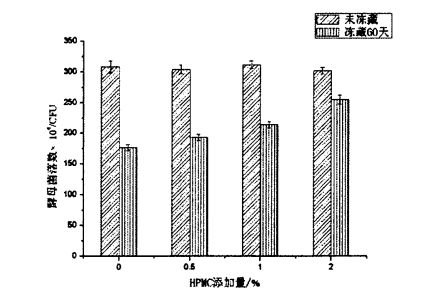
It can be seen from Figure 5.2 that there is no significant difference in the number of yeast colonies in samples with different contents of HPMC added without freezing treatment. Ev wekî encama ku ji hêla Heitmann, Zannini, & Arendt (2015) ve hatî destnîşankirin wekhev e. However, after 60 days of freezing, the number of yeast colonies decreased significantly, from 3.08x106 CFU to 1.76x106 CFU (without adding HPMC); ji 3.04x106 CFU heta 193x106 CFU (0,5% HPMC zêde kirin); Ji 3.12x106 CFU ji 2.14x106 CFU kêm kir (1% HPMC); Ji 3.02x106 CFU ji 2.55x106 CFU kêm kirin (2% HPMC). By comparison, it can be found that the freezing storage environment stress led to the decrease of the yeast colony number, but with the increase of HPMC addition, the degree of the decrease of the colony number decreased in turn. This indicates that HPMC can better protect yeast under freezing conditions. The mechanism of protection may be the same as that of glycerol, a commonly used strain antifreeze, mainly by inhibiting the formation and growth of ice crystals and reducing the stress of low temperature environment to yeast. Figure 5.3 is the photomicrograph taken from the 3M yeast rapid counting test piece after preparation and microscopic examination, which is in line with the external morphology of yeast.
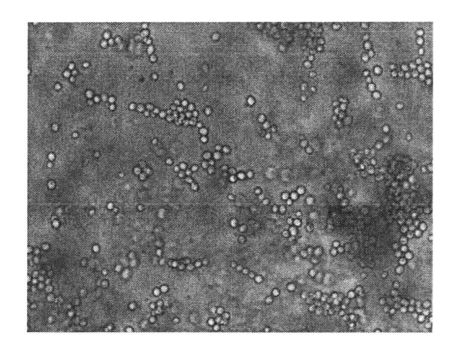
Fig 5.3 MicroG Micrograf of Yasts
5.3.3 Effects of Addition HPMC - Wextê serbestberdana li ser naveroka glutathione di Dough
Glutathione is a tripeptide compound composed of glutamic acid, cysteine and glycine, and has two types: reduced and oxidized. When the yeast cell structure is destroyed and died, the permeability of the cells increases, and the intracellular glutathione is released to the outside of the cell, and it is reductive. It is particularly worth noting that reduced glutathione will reduce the disulfide bonds (-SS-) formed by the cross-linking of gluten proteins, breaking them to form free sulfhydryl groups (.SH), which in turn affects the dough network structure. aramî û yekparêzî, û di dawiyê de rê li ber xirabûna kalîteya hilberên fêkiyên fêkiyan. Usually, under environmental stress (such as low temperature, high temperature, high osmotic pressure, etc.), yeast will reduce its own metabolic activity and increase its stress resistance, or produce spores at the same time. When the environmental conditions are suitable for its growth and reproduction again, then restore the metabolism and proliferation vitality. However, some yeasts with poor stress resistance or strong metabolic activity will still die if they are kept in a frozen storage environment for a long time.
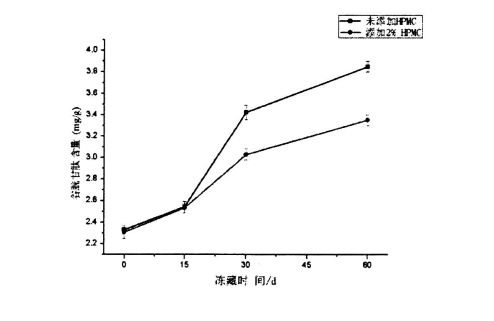
Fig 5.4 Bandora HPMC-ê ya HPMC-ê û hilanîna berfê li ser naveroka Glutathione (GSH)
Wekî ku di Figure 5.4 de tê nîşandan, naveroka Glutathione bêyî ku HPMC zêde bû zêde bû an na, û cûdahiya girîng di navbera mîqdarên cûda de tunebû. This may be because some of the active dry yeast used to make the dough have poor stress resistance and tolerance. Di bin şertê germahiya berfirehkirinê de, hucreyan dimirin, û dûv re Glutathione serbest tê berdan, ku tenê bi taybetmendiyên xwê bixwe ve girêdayî ye. Ew bi hawîrdora derve re têkildar e, lê bi mîqdara HPMC-ê re tiştek tune. Ji ber vê yekê, naveroka Glutathione di nav 15 rojan de zêdebûna serbestberdana zêde bû û di navbera herduyan de cûdahiyek girîng tune. However, with the further extension of the freezing time, the increase of glutathione content decreased with the increase of HPMC addition, and the glutathione content of the bacterial solution without HPMC was increased from 2.329a: 0.040mg/ g (frozen storage for 0 days) increased to 3.8514-0.051 mg/g (frozen storage for 60 days); while the yeast liquid added 2% HPMC, its glutathione content increased from 2.307+0 .058 mg/g (frozen storage for 0 days) rose to 3.351+0.051 mg/g (frozen storage for 60 days). This further indicated that HPMC could better protect yeast cells and reduce the death of yeast, thereby reducing the content of glutathione released to the outside of the cell. This is mainly because HPMC can reduce the number of ice crystals, thereby effectively reducing the stress of ice crystals to yeast and inhibiting the increase of extracellular release of glutathione.
Yeast is an indispensable and important component in fermented flour products, and its fermentation activity will directly affect the quality of the final product. In this experiment, the protective effect of HPMC on yeast in frozen dough system was evaluated by studying the effect of different HPMC additions on yeast fermentation activity, yeast survival number, and extracellular glutathione content in frozen dough. Bi ceribandinan, hat dîtin ku zêdebûna HPMC dikare baştir çalakiya fermandasyonê baştir bike, û asta hilweşîna li ser bilindbûna dûkelê piştî 60 rojan ji bo hilbera taybetî ya hilbera paşîn peyda bike; in addition, the addition of HPMC effectively The decrease of yeast survival number was inhibited and the increase rate of reduced glutathione content was reduced, thereby alleviating the damage of glutathione to dough network structure. This suggests that HPMC can protect yeast by inhibiting the formation and growth of ice crystals.
Demjimêra paşîn: Oct-08-2022







